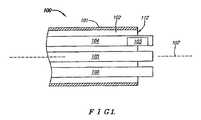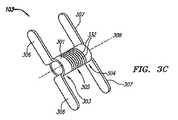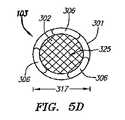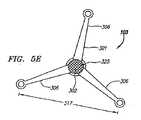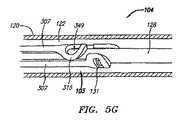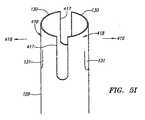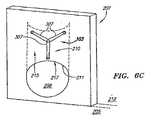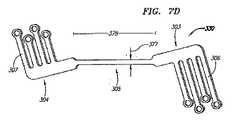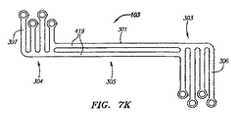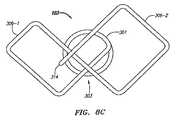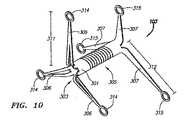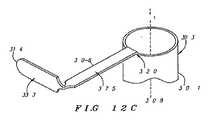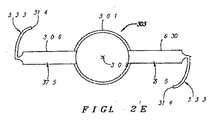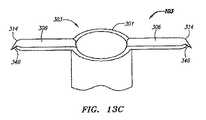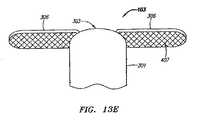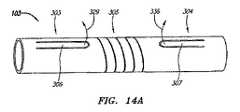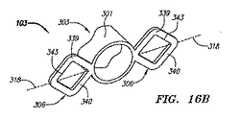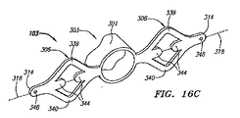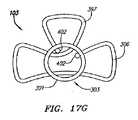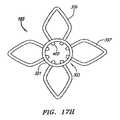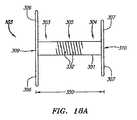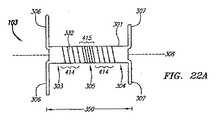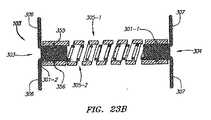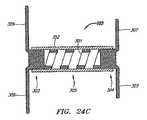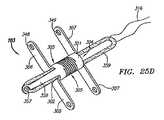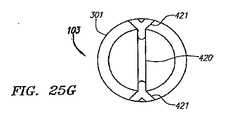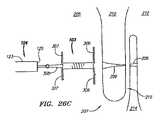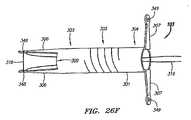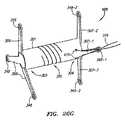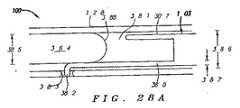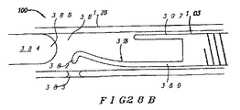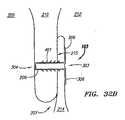JP2009518149A - Clip-based system and method for treating septal defects - Google Patents
Clip-based system and method for treating septal defectsDownload PDFInfo
- Publication number
- JP2009518149A JP2009518149AJP2008544626AJP2008544626AJP2009518149AJP 2009518149 AJP2009518149 AJP 2009518149AJP 2008544626 AJP2008544626 AJP 2008544626AJP 2008544626 AJP2008544626 AJP 2008544626AJP 2009518149 AJP2009518149 AJP 2009518149A
- Authority
- JP
- Japan
- Prior art keywords
- clip
- members
- tubular
- configuration
- pattern portion
- Prior art date
- Legal status (The legal status is an assumption and is not a legal conclusion. Google has not performed a legal analysis and makes no representation as to the accuracy of the status listed.)
- Pending
Links
Images
Classifications
- A—HUMAN NECESSITIES
- A61—MEDICAL OR VETERINARY SCIENCE; HYGIENE
- A61B—DIAGNOSIS; SURGERY; IDENTIFICATION
- A61B17/00—Surgical instruments, devices or methods
- A61B17/0057—Implements for plugging an opening in the wall of a hollow or tubular organ, e.g. for sealing a vessel puncture or closing a cardiac septal defect
- A—HUMAN NECESSITIES
- A61—MEDICAL OR VETERINARY SCIENCE; HYGIENE
- A61B—DIAGNOSIS; SURGERY; IDENTIFICATION
- A61B17/00—Surgical instruments, devices or methods
- A61B17/12—Surgical instruments, devices or methods for ligaturing or otherwise compressing tubular parts of the body, e.g. blood vessels or umbilical cord
- A61B17/12022—Occluding by internal devices, e.g. balloons or releasable wires
- A61B17/12099—Occluding by internal devices, e.g. balloons or releasable wires characterised by the location of the occluder
- A61B17/12122—Occluding by internal devices, e.g. balloons or releasable wires characterised by the location of the occluder within the heart
- A—HUMAN NECESSITIES
- A61—MEDICAL OR VETERINARY SCIENCE; HYGIENE
- A61B—DIAGNOSIS; SURGERY; IDENTIFICATION
- A61B17/00—Surgical instruments, devices or methods
- A61B17/22—Implements for squeezing-off ulcers or the like on inner organs of the body; Implements for scraping-out cavities of body organs, e.g. bones; for invasive removal or destruction of calculus using mechanical vibrations; for removing obstructions in blood vessels, not otherwise provided for
- A61B17/221—Gripping devices in the form of loops or baskets for gripping calculi or similar types of obstructions
- A—HUMAN NECESSITIES
- A61—MEDICAL OR VETERINARY SCIENCE; HYGIENE
- A61B—DIAGNOSIS; SURGERY; IDENTIFICATION
- A61B17/00—Surgical instruments, devices or methods
- A61B17/00234—Surgical instruments, devices or methods for minimally invasive surgery
- A61B2017/00238—Type of minimally invasive operation
- A61B2017/00243—Type of minimally invasive operation cardiac
- A61B2017/00247—Making holes in the wall of the heart, e.g. laser Myocardial revascularization
- A—HUMAN NECESSITIES
- A61—MEDICAL OR VETERINARY SCIENCE; HYGIENE
- A61B—DIAGNOSIS; SURGERY; IDENTIFICATION
- A61B17/00—Surgical instruments, devices or methods
- A61B17/0057—Implements for plugging an opening in the wall of a hollow or tubular organ, e.g. for sealing a vessel puncture or closing a cardiac septal defect
- A61B2017/00575—Implements for plugging an opening in the wall of a hollow or tubular organ, e.g. for sealing a vessel puncture or closing a cardiac septal defect for closure at remote site, e.g. closing atrial septum defects
- A—HUMAN NECESSITIES
- A61—MEDICAL OR VETERINARY SCIENCE; HYGIENE
- A61B—DIAGNOSIS; SURGERY; IDENTIFICATION
- A61B17/00—Surgical instruments, devices or methods
- A61B17/0057—Implements for plugging an opening in the wall of a hollow or tubular organ, e.g. for sealing a vessel puncture or closing a cardiac septal defect
- A61B2017/00575—Implements for plugging an opening in the wall of a hollow or tubular organ, e.g. for sealing a vessel puncture or closing a cardiac septal defect for closure at remote site, e.g. closing atrial septum defects
- A61B2017/00579—Barbed implements
- A—HUMAN NECESSITIES
- A61—MEDICAL OR VETERINARY SCIENCE; HYGIENE
- A61B—DIAGNOSIS; SURGERY; IDENTIFICATION
- A61B17/00—Surgical instruments, devices or methods
- A61B17/0057—Implements for plugging an opening in the wall of a hollow or tubular organ, e.g. for sealing a vessel puncture or closing a cardiac septal defect
- A61B2017/00575—Implements for plugging an opening in the wall of a hollow or tubular organ, e.g. for sealing a vessel puncture or closing a cardiac septal defect for closure at remote site, e.g. closing atrial septum defects
- A61B2017/00592—Elastic or resilient implements
- A—HUMAN NECESSITIES
- A61—MEDICAL OR VETERINARY SCIENCE; HYGIENE
- A61B—DIAGNOSIS; SURGERY; IDENTIFICATION
- A61B17/00—Surgical instruments, devices or methods
- A61B17/0057—Implements for plugging an opening in the wall of a hollow or tubular organ, e.g. for sealing a vessel puncture or closing a cardiac septal defect
- A61B2017/00575—Implements for plugging an opening in the wall of a hollow or tubular organ, e.g. for sealing a vessel puncture or closing a cardiac septal defect for closure at remote site, e.g. closing atrial septum defects
- A61B2017/00606—Implements H-shaped in cross-section, i.e. with occluders on both sides of the opening
- A—HUMAN NECESSITIES
- A61—MEDICAL OR VETERINARY SCIENCE; HYGIENE
- A61B—DIAGNOSIS; SURGERY; IDENTIFICATION
- A61B17/00—Surgical instruments, devices or methods
- A61B17/0057—Implements for plugging an opening in the wall of a hollow or tubular organ, e.g. for sealing a vessel puncture or closing a cardiac septal defect
- A61B2017/00575—Implements for plugging an opening in the wall of a hollow or tubular organ, e.g. for sealing a vessel puncture or closing a cardiac septal defect for closure at remote site, e.g. closing atrial septum defects
- A61B2017/00615—Implements with an occluder on one side of the opening and holding means therefor on the other
- A—HUMAN NECESSITIES
- A61—MEDICAL OR VETERINARY SCIENCE; HYGIENE
- A61B—DIAGNOSIS; SURGERY; IDENTIFICATION
- A61B17/00—Surgical instruments, devices or methods
- A61B17/0057—Implements for plugging an opening in the wall of a hollow or tubular organ, e.g. for sealing a vessel puncture or closing a cardiac septal defect
- A61B2017/00575—Implements for plugging an opening in the wall of a hollow or tubular organ, e.g. for sealing a vessel puncture or closing a cardiac septal defect for closure at remote site, e.g. closing atrial septum defects
- A61B2017/00619—Locking means for locking the implement in expanded state
- A—HUMAN NECESSITIES
- A61—MEDICAL OR VETERINARY SCIENCE; HYGIENE
- A61B—DIAGNOSIS; SURGERY; IDENTIFICATION
- A61B17/00—Surgical instruments, devices or methods
- A61B17/0057—Implements for plugging an opening in the wall of a hollow or tubular organ, e.g. for sealing a vessel puncture or closing a cardiac septal defect
- A61B2017/00575—Implements for plugging an opening in the wall of a hollow or tubular organ, e.g. for sealing a vessel puncture or closing a cardiac septal defect for closure at remote site, e.g. closing atrial septum defects
- A61B2017/00623—Introducing or retrieving devices therefor
- A—HUMAN NECESSITIES
- A61—MEDICAL OR VETERINARY SCIENCE; HYGIENE
- A61B—DIAGNOSIS; SURGERY; IDENTIFICATION
- A61B17/00—Surgical instruments, devices or methods
- A61B2017/00831—Material properties
- A61B2017/00867—Material properties shape memory effect
- A—HUMAN NECESSITIES
- A61—MEDICAL OR VETERINARY SCIENCE; HYGIENE
- A61B—DIAGNOSIS; SURGERY; IDENTIFICATION
- A61B17/00—Surgical instruments, devices or methods
- A61B2017/00831—Material properties
- A61B2017/00893—Material properties pharmaceutically effective
- A—HUMAN NECESSITIES
- A61—MEDICAL OR VETERINARY SCIENCE; HYGIENE
- A61B—DIAGNOSIS; SURGERY; IDENTIFICATION
- A61B17/00—Surgical instruments, devices or methods
- A61B17/04—Surgical instruments, devices or methods for suturing wounds; Holders or packages for needles or suture materials
- A61B17/0401—Suture anchors, buttons or pledgets, i.e. means for attaching sutures to bone, cartilage or soft tissue; Instruments for applying or removing suture anchors
- A61B2017/0412—Suture anchors, buttons or pledgets, i.e. means for attaching sutures to bone, cartilage or soft tissue; Instruments for applying or removing suture anchors having anchoring barbs or pins extending outwardly from suture anchor body
- A—HUMAN NECESSITIES
- A61—MEDICAL OR VETERINARY SCIENCE; HYGIENE
- A61B—DIAGNOSIS; SURGERY; IDENTIFICATION
- A61B17/00—Surgical instruments, devices or methods
- A61B17/04—Surgical instruments, devices or methods for suturing wounds; Holders or packages for needles or suture materials
- A61B17/0401—Suture anchors, buttons or pledgets, i.e. means for attaching sutures to bone, cartilage or soft tissue; Instruments for applying or removing suture anchors
- A61B2017/0419—H-fasteners
- A—HUMAN NECESSITIES
- A61—MEDICAL OR VETERINARY SCIENCE; HYGIENE
- A61B—DIAGNOSIS; SURGERY; IDENTIFICATION
- A61B17/00—Surgical instruments, devices or methods
- A61B17/04—Surgical instruments, devices or methods for suturing wounds; Holders or packages for needles or suture materials
- A61B17/0401—Suture anchors, buttons or pledgets, i.e. means for attaching sutures to bone, cartilage or soft tissue; Instruments for applying or removing suture anchors
- A61B2017/042—Suture anchors, buttons or pledgets, i.e. means for attaching sutures to bone, cartilage or soft tissue; Instruments for applying or removing suture anchors plastically deformed during insertion
- A61B2017/0422—Suture anchors, buttons or pledgets, i.e. means for attaching sutures to bone, cartilage or soft tissue; Instruments for applying or removing suture anchors plastically deformed during insertion by insertion of a separate member into the body of the anchor
- A—HUMAN NECESSITIES
- A61—MEDICAL OR VETERINARY SCIENCE; HYGIENE
- A61B—DIAGNOSIS; SURGERY; IDENTIFICATION
- A61B17/00—Surgical instruments, devices or methods
- A61B17/22—Implements for squeezing-off ulcers or the like on inner organs of the body; Implements for scraping-out cavities of body organs, e.g. bones; for invasive removal or destruction of calculus using mechanical vibrations; for removing obstructions in blood vessels, not otherwise provided for
- A61B2017/22038—Implements for squeezing-off ulcers or the like on inner organs of the body; Implements for scraping-out cavities of body organs, e.g. bones; for invasive removal or destruction of calculus using mechanical vibrations; for removing obstructions in blood vessels, not otherwise provided for with a guide wire
- A61B2017/22047—Means for immobilising the guide wire in the patient
- A—HUMAN NECESSITIES
- A61—MEDICAL OR VETERINARY SCIENCE; HYGIENE
- A61B—DIAGNOSIS; SURGERY; IDENTIFICATION
- A61B17/00—Surgical instruments, devices or methods
- A61B17/28—Surgical forceps
- A61B17/29—Forceps for use in minimally invasive surgery
- A61B2017/2926—Details of heads or jaws
- A—HUMAN NECESSITIES
- A61—MEDICAL OR VETERINARY SCIENCE; HYGIENE
- A61B—DIAGNOSIS; SURGERY; IDENTIFICATION
- A61B17/00—Surgical instruments, devices or methods
- A61B17/30—Surgical pincettes, i.e. surgical tweezers without pivotal connections
- A61B2017/306—Surgical pincettes, i.e. surgical tweezers without pivotal connections holding by means of suction
- A—HUMAN NECESSITIES
- A61—MEDICAL OR VETERINARY SCIENCE; HYGIENE
- A61B—DIAGNOSIS; SURGERY; IDENTIFICATION
- A61B18/00—Surgical instruments, devices or methods for transferring non-mechanical forms of energy to or from the body
- A61B2018/00315—Surgical instruments, devices or methods for transferring non-mechanical forms of energy to or from the body for treatment of particular body parts
- A61B2018/00345—Vascular system
- A61B2018/00351—Heart
- A61B2018/00392—Transmyocardial revascularisation
Landscapes
- Health & Medical Sciences (AREA)
- Surgery (AREA)
- Life Sciences & Earth Sciences (AREA)
- Biomedical Technology (AREA)
- Medical Informatics (AREA)
- Veterinary Medicine (AREA)
- Public Health (AREA)
- Engineering & Computer Science (AREA)
- Cardiology (AREA)
- Heart & Thoracic Surgery (AREA)
- Nuclear Medicine, Radiotherapy & Molecular Imaging (AREA)
- Molecular Biology (AREA)
- Animal Behavior & Ethology (AREA)
- General Health & Medical Sciences (AREA)
- Reproductive Health (AREA)
- Vascular Medicine (AREA)
- Surgical Instruments (AREA)
Abstract
Translated fromJapaneseDescription
Translated fromJapanese (発明の分野)
本発明は、全般的には、中隔欠損などの体内組織の欠損を治療するためのクリップ、ならびにこのクリップを送達するためのシステムおよび方法に関する。(Field of Invention)
The present invention relates generally to clips for treating defects in body tissues, such as septal defects, and systems and methods for delivering the clips.
(発明の背景)
体内組織の欠損は、その位置のために、本質的に治療が困難である。侵襲手術による欠損へのアクセスは、深刻な合併症を患者にもたらす危険性が高い。カテーテルまたは同等装置による欠損への遠隔アクセスは、危険性は低いが、カテーテルの物理的能力が限られているために、欠損自体の治療がより困難になる。欠損が重要臓器の中かまたは近くにある場合は、組織の欠損箇所へのアクセスおよび治療がより困難になる。たとえば、卵円孔開存(「PFO:Patent Foramen Ovale」)は心臓の左心房と右心房の間に発生しうる深刻な中隔欠損であり、動脈管開存(「PDA:Patent Ductus Arteriosus」)は大動脈と肺動脈との間の異常短絡である。(Background of the Invention)
Body tissue defects are inherently difficult to treat because of their location. Access to defects from invasive surgery is at high risk of serious complications to the patient. Remote access to a defect with a catheter or equivalent device is less risky, but the physical capacity of the catheter is limited, making it more difficult to treat the defect itself. If the defect is in or near a vital organ, access and treatment of the tissue defect becomes more difficult. For example, patent foramen ovale ("PFO") is a severe septal defect that can occur between the left and right atria of the heart and is known as "patent ductus arteriosus"("PDA"). ) Is an abnormal short circuit between the aorta and the pulmonary artery.
子宮内での胎児の発育中、発育中の胎児の脈管構造と母親の胎盤との間の複雑な相互作用によって、酸素は母体血から胎児血に移される。この過程中、胎児の肺内では血液に酸素が送り込まれない。実際に、胎児の血液循環の大半は、胎生期には開いているが一般に生後間もない時期に閉じる孔と専用の血管とを通り、肺を迂回する。ただし、ときとして、これらの孔が閉じず、血行動態上の問題を引き起こすことがある。この問題は、極端な場合は致命的となりうる。胎生期においては、卵円孔と呼ばれる開口部によって、血液は肺を迂回し、右心房から左心房に直接移動する。したがって、胎盤とのガス交換によって酸素を含んだ血液は、大静脈から右心房へ、卵円孔を通って左心房へ、さらに左心房から左心室へと移動することによって胎児の体循環に送達される。誕生後、肺循環が確立すると、左心房内の血流および血圧の増大によって、卵円孔の機能的閉鎖が引き起こされ、心臓の発達に伴い、この閉鎖によって卵円孔の完全封止が可能になる。 During fetal development in the uterus, oxygen is transferred from maternal blood to fetal blood due to complex interactions between the developing fetal vasculature and the mother's placenta. During this process, oxygen is not pumped into the blood in the fetal lungs. In fact, most of the blood circulation of the fetus bypasses the lungs through a hole that is open during the embryonic period but generally closed at an early age and dedicated blood vessels. However, sometimes these holes do not close, causing hemodynamic problems. This problem can be fatal in extreme cases. During the embryonic period, an opening called the foramen ovale causes blood to bypass the lungs and move directly from the right atrium to the left atrium. Therefore, oxygen-containing blood through gas exchange with the placenta is delivered to the fetal systemic circulation by moving from the vena cava to the right atrium, through the foramen ovale to the left atrium, and from the left atrium to the left ventricle. Is done. After birth, when the pulmonary circulation is established, the increase in blood flow and blood pressure in the left atrium causes the functional closure of the foramen ovale, which, along with the development of the heart, allows for complete closure of the foramen ovale Become.
ただし、場合によっては、卵円孔が完全に封鎖されない。この状態は、PFOとして公知であり、心臓の左心房と右心房との間での血液の短絡が個人の成年期にわたって継続することもある。PFOは、脳卒中および片頭痛などの深刻な健康上の危険を個人に引き起こしうる。PFOの存在は、片頭痛の発症要因の1つに関係があるとされている。PFOを片頭痛に結び付ける現在の2つの仮説として、静脈血が肺を通過せずに左心房に直接循環するために、通常は肺においてそれぞれ不活性化または濾過される血管刺激物質または血栓/塞栓が左心房に移送されることが挙げられる。PFOに伴う他の疾患(およびPFOの閉鎖により改善されうる疾患)として、抑うつ症および情動障害、人格障害および不安障害、痛み、発作、TIA、痴呆、てんかん、および睡眠障害が挙げられるが、これだけに限定されるものではない。 However, in some cases, the foramen ovale is not completely sealed. This condition is known as PFO, and a blood short circuit between the left and right atria of the heart may continue throughout the adult life of the individual. PFO can pose serious health risks to individuals, such as stroke and migraine. The presence of PFO has been implicated in one of the causes of migraine. Two current hypotheses linking PFO to migraine are vascular stimulators or thrombus / emboli that are normally inactivated or filtered in the lung, respectively, because venous blood circulates directly to the left atrium without passing through the lung Is transferred to the left atrium. Other diseases associated with PFO (and those that can be ameliorated by PFO closure) include, but are not limited to, depression and affective disorders, personality and anxiety disorders, pain, seizures, TIA, dementia, epilepsy, and sleep disorders It is not limited to.
心臓のさまざまな室の間に発生しうるその他の中隔欠損症として、心房中隔欠損症(ASD:Atrial−Septal Defect)、心室中隔欠損症(VSD:Ventricular−Septal Defect)等が挙げられる。これらの欠損およびPFOを治療するには、心臓切開手術を行って欠損を結紮するか、またはパッチによって閉鎖できる。あるいは、カテーテルを用いた措置が開発されているが、この措置では傘状または円板状の装置を心臓内に導入する必要がある。これらの装置は、ハブまたは腰部によって接続される複数の対向する拡張可能な構造体を含む。通常、欠損を閉鎖する試みにおいては、欠損の自然な開口部を通して装置を挿入し、拡張可能な構造体を中隔の両側で配備(deploy)させることによって傘状または円板状の構造体間に欠損の周囲の組織を固定する。 Other septal defects that can occur between various chambers of the heart include atrial septal defect (ASD), ventricular-septal defect (VSD), and the like. . To treat these defects and PFOs, open-heart surgery can be performed and the defects can be ligated or closed with a patch. Alternatively, a procedure using a catheter has been developed, which requires the introduction of an umbrella-shaped or disc-shaped device into the heart. These devices include a plurality of opposing expandable structures connected by a hub or waist. Usually, in an attempt to close the defect, the device is inserted through the defect's natural opening, and the expandable structure is deployed on both sides of the septum, between the umbrella-like or disc-like structures. To fix the tissue around the defect.
これらの装置は数多くの欠点を有する。たとえば、これらの装置は、多くの場合、膜を支持する複数の枠構造を一般に含み、これらの構造のどちらか一方が患者の生存中に破損すると、欠損が再度開くか、または装置の複数の部分が患者の心臓内に放出されうるという危険を伴う。これらの装置が中隔欠損の完全な封止を形成できないために、欠損を通じて血液が短絡し続けることもある。さらに、これらの装置のサイズおよび拡張性により、装置の回収が必要になった場合に、患者からの安全な回収が困難な場合がある。これらの装置を心臓内に留置しておくには、一般に患者は抗凝固薬を長期間使用する必要があるため、さらなる健康上の危険が患者に生じる。さらに、これらの装置は心臓組織の他の複数の部分に接触しうるので、不整脈、組織の局所的損傷、および穿孔などの望ましくない副作用を引き起こしうる。 These devices have a number of drawbacks. For example, these devices often include a plurality of frameworks that support the membrane, and if either of these structures breaks during the patient's life, the defect reopens or the devices There is a risk that the part can be released into the patient's heart. Because these devices cannot form a complete seal of a septal defect, blood may continue to short circuit through the defect. In addition, the size and expandability of these devices can make it difficult to safely retrieve them from the patient when device retrieval becomes necessary. In order to keep these devices in the heart, patients generally need to use anticoagulants for extended periods of time, creating additional health risks for the patient. In addition, these devices can contact other parts of the heart tissue, which can cause undesirable side effects such as arrhythmia, local tissue damage, and perforation.
したがって、心臓内の内部組織の欠損を治療および閉鎖するための改良された装置、システム、および方法が必要とされている。 Accordingly, there is a need for improved devices, systems, and methods for treating and closing internal tissue defects in the heart.
(概要)
本節では、中隔欠損等の体内組織の欠損を閉鎖するための改良されたクリップを用いた装置、システム、および方法を例示的実施態様として提供する。これらの実施態様は単なる例であり、本発明を制限するものではない。(Overview)
In this section, devices, systems, and methods using improved clips for closing defects in body tissue, such as septal defects, are provided as exemplary embodiments. These embodiments are merely examples and do not limit the invention.
一例示的実施態様において、体内組織の欠損を治療するための医療装置は、内腔を有する細長い管状本体と、管状本体に連結された第1の部材であって、内腔から外方に偏向して第1の組織表面に当接するように構成された姿勢にバイアスされる第1の部材と、管状本体に連結された第2の部材であって、内腔から外方に偏向して第2の組織表面に当接するように構成された姿勢にバイアスされる第2の部材とを含み、第1および第2の部材はその間に第1および第2の組織表面を保持するように構成される。 In one exemplary embodiment, a medical device for treating a tissue defect is an elongated tubular body having a lumen and a first member coupled to the tubular body, the deflecting outward from the lumen. A first member biased to a posture configured to abut against the first tissue surface and a second member coupled to the tubular body, wherein the first member is deflected outwardly from the lumen. A second member biased in a posture configured to abut against the two tissue surfaces, wherein the first and second members are configured to hold the first and second tissue surfaces therebetween. The
別の例示的実施態様において、体内組織の欠損を治療するための医療装置は、ほぼ剛性の本体を含み、本体は第1の端部と第2の端部とを本体の第1の軸に沿った位置に備え、第1の端部と第2の端部とは相互に可撓可能に連結され、かつ可変距離で離隔され、第1の端部には第1の部材の基部が連結され、第1の部材は第1の向きと第2向きの間で偏向可能であり、第1の部材の一部は、第1の向きにおける第1の軸からのオフセットが第2の向きにおけるオフセットより大きく、第2の端部には第2の部材の基部が連結され、第2の部材は第1の向きと第2の向きの間で偏向可能であり、第2の部材の一部は、第1の向きにおける第1の軸からのオフセットが第2の向きにおけるオフセットより大きい。 In another exemplary embodiment, a medical device for treating a tissue defect includes a generally rigid body, the body having a first end and a second end on a first axis of the body. The first end and the second end are connected to each other in a flexible manner and are separated by a variable distance, and the base of the first member is connected to the first end. The first member is deflectable between a first orientation and a second orientation, and a portion of the first member is offset from the first axis in the first orientation in the second orientation. Greater than the offset, the second end is coupled to the base of the second member, the second member is deflectable between the first orientation and the second orientation, and part of the second member Is greater in offset from the first axis in the first orientation than in the second orientation.
中隔欠損を治療するための治療システムの一例示的実施形態において、当該システムは、ほぼ剛性の本体とこの本体に連結された複数の偏向可能部材とを有し、偏向可能部材が未配備(undeployed)形態から配備形態に偏向するように構成された、隔壁内に送達可能なクリップであって、配備形態において複数の偏向可能部材によって隔壁の中隔欠損を少なくとも部分的に閉鎖するように構成されたクリップと、このクリップを隔壁に送達するように構成された細長い送達装置とを含む。 In one exemplary embodiment of a treatment system for treating a septal defect, the system has a generally rigid body and a plurality of deflectable members coupled to the body, the deflectable member being undeployed ( A clip deliverable into the septum configured to deflect from an undeployed configuration to a deployed configuration configured to at least partially close a septal defect in the septum with a plurality of deflectable members in the deployed configuration And an elongated delivery device configured to deliver the clip to the septum.
中隔欠損を治療する方法の一例示的実施態様において、当該方法は、第1の偏向可能部材と第2の偏向可能部材とを備える管状本体を有するクリップを隔壁の少なくとも一部を貫通して延在する穴に送達するステップと、第1の部材を偏向させて隔壁の第1の側にある第1の中隔組織表面に当接する姿勢にするステップと、隔壁の中隔欠損トンネルが第1および第2の部材の間で少なくとも部分的に閉鎖された状態に保持されるように第2の部材を偏向させて隔壁の第2の側にある第2の組織表面に当接する姿勢にするステップとを含む。 In one exemplary embodiment of a method for treating a septal defect, the method includes passing a clip having a tubular body with a first deflectable member and a second deflectable member through at least a portion of a septum. Delivering to the extending hole; deflecting the first member to abut against the first septal tissue surface on the first side of the septum; and a septal defect tunnel in the septum The second member is deflected to abut against the second tissue surface on the second side of the septum so as to be held at least partially closed between the first and second members. Steps.
中隔欠損を治療するために構成された医療装置を製造する方法の一例示的実施態様において、当該方法は、第1の部材が連結された第1の端部と、第2の部材が連結された第2の端部と、第1および第2の端部の間に位置する中心部とを備えるクリップパターン部分を形状記憶材料の管から形成するステップと、第1および第2の部材がバイアスされて外方に偏向するようにクリップパターン部分を処理するステップと、を含む。 In one exemplary embodiment of a method of manufacturing a medical device configured for treating a septal defect, the method includes a first end to which a first member is connected and a second member to be connected. Forming a clip pattern portion from a shape memory material tube comprising a second end portion formed and a central portion located between the first and second ends; and the first and second members include: Processing the clip pattern portion to be biased and deflect outward.
中隔欠損症を治療するために構成された医療装置の製造方法の別の例示的実施形態において、当該方法は、第1の端部と、第2の部材が連結された第2の端部と、第1および第2の端部の間に位置する中心部とを備えるクリップパターン部分を形状記憶材料のシートから形成するステップと、当該シートのクリップパターン部分を管状形態に形作るステップと、この管状形態を保持するためにクリップパターン部分を構成するステップと、第1および第2の部材がバイアスされて外方に偏向するようにクリップパターン部分を処理するステップとを含む。 In another exemplary embodiment of a method of manufacturing a medical device configured to treat a septal defect, the method includes a first end and a second end to which a second member is coupled. Forming a clip pattern portion from a sheet of shape memory material comprising a central portion located between the first and second ends, and forming the clip pattern portion of the sheet into a tubular form, Configuring the clip pattern portion to retain a tubular form and processing the clip pattern portion such that the first and second members are biased to deflect outward.
本発明の他のシステム、方法、特徴、および利点は、当業者には明らかであるか、または以下の図および詳細説明を検討することにより明らかになるであろう。その他のこのようなシステム、方法、特徴、および利点はこの説明に含まれ、本発明の範囲内にあり、付属の請求の範囲によって保護されるものとする。さらに、本発明は、上記の実施例の詳細内容を要するものだけに限定されないものとする。 Other systems, methods, features and advantages of the present invention will be apparent to those skilled in the art or upon review of the following figures and detailed description. Other such systems, methods, features, and advantages are included in this description, are within the scope of the invention, and are intended to be protected by the accompanying claims. Further, the present invention is not limited to only those requiring the detailed contents of the above embodiments.
本発明の詳細は、本発明の構造および動作の両方に関して、付属の図を検討することによって部分的に突き止めうる。これらの図において、同様の参照数字は同様の部品を指す。これらの図中の構成要素は、必ずしも正確な縮尺ではなく、むしろ本発明の原理を示すことに焦点が置かれている。さらに、あらゆる説明図は概念の伝達を目的とし、相対サイズ、形状、および他の詳細な属性の描写は、正確または厳密というより、模式的になされていることもある。 The details of the invention may be ascertained in part by examining the accompanying figures with respect to both structure and operation of the invention. In these figures, like reference numerals refer to like parts. The components in these figures are not necessarily to scale, but rather focus on illustrating the principles of the invention. In addition, all illustrations are intended to convey concepts, and the relative size, shape, and other detailed attribute descriptions may be schematic rather than precise or precise.
本願明細書においては、体内組織の欠損を治療するための変形可能なクリップ型装置、ならびにこれらの装置を送達するためのシステム、およびこれらの使用方法について説明する。説明を簡単にするために、これらの装置、システム、および方法をPFOの治療に関連して説明する。ただし、これらの装置、システム、および方法は、ASD、VSD等を含むあらゆる種類の中隔欠損のほか、PDA、肺シャント、あるいは心臓または血管の他の構造的欠損または血管以外の欠損、および中隔組織以外の組織の欠損を含む他の何れの組織の欠損の治療にも使用できることを理解されたい。 Described herein are deformable clip-type devices for treating body tissue defects, systems for delivering these devices, and methods of use thereof. For ease of explanation, these devices, systems, and methods are described in the context of treating PFO. However, these devices, systems, and methods include all types of septal defects, including ASD, VSD, etc., as well as PDA, lung shunts, or other structural or non-vascular defects in the heart or blood vessels, and medium It should be understood that it can be used to treat defects in any other tissue, including defects in tissues other than the septal tissue.
図1は、PFOの治療、好ましくは閉鎖、を行うために構成された中隔欠損治療システム100の一例示的実施形態の遠位部を示すブロック図である。この実施形態において、治療システム100は、中隔欠損を有する患者(ヒトまたは動物)の脈管構造内に挿入されるように構成された細長い本体部材101を含む。本体部材101は、長手軸107と遠位端112とを有し、1つ以上の内腔102を含むことができる。各内腔102は、複数の機能を実現するようにそれぞれ構成できる。治療システム100は、中隔欠損の部分的または全面的閉鎖を容易にするように構成された埋め込み可能な装置103を含むことが好ましい。 FIG. 1 is a block diagram illustrating the distal portion of one exemplary embodiment of a septal
埋め込み可能な装置103は、管状のクリップのように構成されることが好ましい。この説明を容易にするために、本願明細書では、埋め込み可能な装置103をクリップ103と称する。治療システム100は、クリップ103を収容および送達するように構成された可撓性の細長い送達装置104を含むことができる。クリップ103は、配備形態と未配備すなわち収容形態との間で変形可能(すなわち、圧力、応力、または先在するバイアス力によって形状の変形または変更が可能)、偏向可能、または形状変化可能にできる。本体部材101の半径方向断面幅を最小化して配備を助けるために、未配備形態におけるクリップ103の横断面形状は、配備形態におけるクリップ103の横断面形状より小さいことが好ましい。これにより、クリップ103をさらに小型化して送達装置104内に収容できるため、中隔壁経由での、または中隔壁内への、送達がより容易になる。 The
治療システム100は、場合によっては、クリップ103送達中に本体部材101を安定化させる安定化装置105と、送達のための送達装置104の位置決めまたはセンタリングを容易にする位置決め装置106とをさらに含むこともできる。ここには4つの独立した構成要素として図示されているが、治療システム100内の構成要素の合計数を3つ、2つ、または1つに減らすために、本体部材101と、送達装置104と、安定化装置105と、センタリング装置106とを任意に組み合わせて一体化することができる。ユーザは、送達装置104、安定化装置105、およびセンタリング装置106の操作を本体部材101(図示せず)の近位端で行える。本体部材101と、送達装置104と、安定化装置105と、センタリング装置106とを有する同様の治療システム100の使用方法は、同時継続出願中の2005年7月5日出願の米国特許出願第11/175,814号「Systems and Methods for Treating Septal Defects」の明細書、および2005年9月1日出願の米国特許出願第11/218,794号「Suture−based Systems and Methods for Treating Septal Defects」の明細書に詳細に説明されており、両米国特許出願の内容は、参照により本明細書に援用される。これらの出願はそれぞれコイル状および縫合糸状の装置の送達を主に対象としているが、記載されている送達方法およびシステムの多くは、クリップ103にも等しく適用可能である。 The
治療システム100の多くの代替実施形態の理解を深めるために、PFOを有するヒトの心臓例の解剖学的構造を手短に説明する。図2Aは、下大静脈202および上大静脈203の一部がつながっているヒトの心臓例200を示す外/内面図である。心臓200の組織の外面204と共に、切開部201を通して右心房205の内部が示されている。右心房205の内部には、中隔壁207が示されている。中隔壁207は、右心房205とこの反対側に位置する左心房(図示せず)との間にある。卵円窩208も示されている。卵円窩208は、中隔壁207の一領域であり、その組織は周囲の組織より相対的に薄い。PFO領域209は、卵円窩208の上部にある。 To better understand the many alternative embodiments of the
図2Bは、右心房205側から見たPFO領域209をより詳細に示す、中隔壁207の拡大図である。PFO領域209は、二次中隔210を含む。二次中隔210は、中隔壁207の第1のフラップ状部分である。卵円窩208の上方に位置するこのフラップの縁部は、縁(limbus)211と呼ばれる。図2Cも中隔壁207の拡大図であるが、この図は、左心房212から見た中隔壁207を示す。ここでは、PFO領域209が一次中隔214を含むことが分かる。一次中隔214は、中隔壁207の第2のフラップ状部分である。一次中隔214と二次中隔210の重なり合いが部分的であることによって側壁219(図2B〜Cに破線で示す)間にトンネル状開口部215が画成され、この開口部215を通じて血液が右心房205と左心房212の間で短絡されうる。この開口部215は、一般にPFOと呼ばれる。 FIG. 2B is an enlarged view of the
図2Dは、図2B〜Cの線2D−2Dに沿った例示的PFO領域209を示す断面図である。ここでは、二次中隔210が一次中隔214より厚いことが分かる。一般に、左心房212内の血圧が右心房205内の血圧より高いために、トンネル215は封止されている。ただし、状況によっては、右心房205内の血圧が左心房212内の血圧より高くなり、血液が右心房205から左心房212に短絡するという状態(たとえば、バルサバ(valsava)状態)が発生しうる。一般的な短絡の大半はこのように発生するので、本願明細書の説明を容易にするために、図2Dの領域217をPFOの入口217と称し、領域218をPFOの出口218と称することにする。 FIG. 2D is a cross-sectional view illustrating an
PFOの多数の異なる変形が生じうる。たとえば、一次中隔214の厚み220、二次中隔210の厚み221、重なり合う距離222、一次中隔214および二次中隔210の可撓性および伸張性のどれもが変化しうる。図2B〜Cには、PFOの入口217およびPFOの出口218は相対的に同じ寸法であり、トンネル215の幅、すなわち側壁219間の距離、は比較的一定であるものとして図示されている。ただし、場合によっては、PFOの入口217がPFOの出口218より大きくなり、血液の通過に伴い、トンネル215が収斂することもある。逆に、PFOの入口217がPFOの出口218より小さくなり、血液の通過に伴い、開口部が広がることもある。さらに、PFOの出口218が複数存在し、その間に個別のトンネル215が1つ以上存在することもある。また、図2B〜Dには、一次中隔214および二次中隔210の両方が比較的平面的な組織フラップとして図示されているが、場合によっては一次中隔214および二次中隔210の一方または両方が褶曲した非平面状の極めて不規則な形状を有することもありうる。 Many different variations of PFO can occur. For example, the thickness 220 of the
以下により詳細に説明するように、PFOの治療は、治療システム100を患者の脈管構造に挿入するステップと、右心房205にアクセスできる下大静脈202に脈管構造を通じて本体部材101を(たとえば、ガイドワイヤ沿いに)前進させるステップとを含むことが好ましい。送達装置104が右心房205内に適切に位置付けられたら、送達装置104を用いて1つ以上のクリップ103をPFO領域209に送達することができる。この送達によって、クリップ103がトンネル215に対して横断(transverse)するように置かれてトンネル215を少なくとも部分的に閉鎖するように、各クリップ103が二次中隔210および一次中隔214を貫通して挿入されることが好ましい。このように、クリップを用いた装置、システム、および方法をPFOの治療に用いることによって、PFOトンネル215を直接閉鎖することができる。これに対して、PFOの入口217および出口218を単に閉塞する閉塞型装置では、トンネル215が直接閉鎖されない。 As described in more detail below, the treatment of PFO involves inserting the
クリップ103は、多数のさまざまな形状に構成することができる。図3A〜Cは、クリップ103の一例示的実施形態を示す。クリップ103は、第1の、すなわち遠位の端部303と、第2の、すなわち近位の端部304と、これらの間に位置する中心部305とを有する本体301を含むことが好ましい。第1および第2の端部303および304には、それぞれ中隔組織に当接するように構成された偏向可能(すなわち、曲げ、移動、ひねり、または旋回可能)部材306および307がそれぞれ連結されている。この実施形態において、クリップ103は2つの部材306と2つの部材307とを含んでいるが、1つ以上の任意数の部材306と1つ以上の任意数の部材307とを併用することもできる。偏向可能部材306および307は、クリップ103の送達を容易にするための未配備形態からPFOを治療するための配備形態に偏向するようにバイアスされることが好ましい。
図3Aは、未配備形態のクリップ103を示す部分断面図であり、部材306および307の向きは本体301の主軸308にほぼ沿っている。ここでは、ほぼ鋭利な遠位端121と内腔122とを有する細長い管状部材120の断面内に収容されているクリップ103が示されている。細長い部材120は、偏向可能部材306および307の配備状態への偏向を阻止する。本願明細書の説明を容易にするために、部材120を針120と称することにするが、部材120はこれに限定されるものではない。図3B〜Cは、針120内からの送達後の配備形態のクリップ103をそれぞれ示す正面図および斜視図である。ここでは、各部材306および307の主軸308からのオフセットが未配備状態より大きくなるように、部材306および307は外方に偏向されている。この形態に配備したとき、クリップ103は一次中隔214と二次中隔210とを一緒に保持することによってPFOトンネル215を閉鎖することが好ましい。 FIG. 3A is a partial cross-sectional view showing the
PFOの閉鎖を容易にするために、場合によっては、クリップ103の中心部305が拡張および圧縮するように構成することもできる。この実施形態においては、中心部305は、複数の圧縮性セグメント332を有するバネのように構成される。圧縮/拡張可能な中心部305の動作については、図18A〜24Dを参照して以下により詳細に述べる。なお、中心部305に限らず、クリップ103の任意の部分を圧縮/拡張可能にすることができることに留意されたい。たとえば、1つ以上の圧縮/拡張可能な端部303および304と剛性の中心部305とをクリップ103に設けることもできる。 In some cases, the
図4A〜Dは、図3A〜Bに関して説明したクリップ103の実施形態の心臓200内での一例示的配備手順中の様子を示す部分断面図である。この実施形態においては、針120は、中隔壁207に隣接して位置付けられることが好ましい。次に、針120を用いて中隔壁207を貫くために、図4Aに示されているように遠位端121が左心房212の内部に露出するまで、中隔壁207を通して針120を連続的に前進させる。これによって、二次中隔210および一次中隔214の両方を貫通する開口部206が作られる。 4A-D are partial cross-sectional views illustrating an exemplary deployment procedure within the heart 200 of the embodiment of the
開口部206を通じて左心房212にクリップ103を送達するには、細長いプッシャ部材128を使用することが好ましい。プッシャ部材128は、内腔122内に摺動可能に配設でき、クリップ103に接触して遠位方向に前進し、第1の端部303が針部材120から出て露出されるまでクリップ103を遠位方向に摺動させる。いったん部材306が露出されると、図4Bに示すように、各部材306が自由に偏向し、それぞれのバイアスされた配備形態になる。次に、中隔壁207を通して針部材120を近位側に後退させることができる。次に、プッシャ部材120を引き続き使用して、または部材306を表面213に「引っ掛けて」クリップ103を内腔122から引きずり出すことによって、または何れか他の所望の方法で、クリップ103を内腔122内から完全に配備させることができる。クリップ103が針120の内部から完全に露出されると、図4Cに示すように、部材307が自由に偏向し、それぞれのバイアスされた配備状態になる。 In order to deliver the
完全に配備したクリップ103は、一次中隔214と二次中隔210とが互いに離れないように拘束するように機能することによって、トンネル215内の空間を縮小し、さらにはトンネル215を完全に閉鎖することが好ましい。部材306および307は、比較的均等または均一な量の力をそれぞれ一次中隔214および二次中隔210にわたって加えることが好ましい。均等な量の力を加えることによって一次中隔214が平らになり、二次中隔210に押し当てられると、部材306または307のそれぞれの下での一次中隔214または二次中隔210の丸まりによって生じうる遺残短絡の発生を回避しうる。 The fully deployed
この例においては、偏向可能部材306は左心房(LA)212内で配備され、偏向可能部材307は右心房(RA)205内で配備される。本願明細書の説明を容易にするために、偏向可能部材306および307をそれぞれLA部材306およびRA部材307と称するが、偏向可能部材306および307はこれに限定されるものではない。 In this example,
上記のように、本体301の中心部305は、トンネル215の閉鎖を容易にするために、拡張および圧縮可能に構成されることが好ましい。この実施形態において、中心部305は、本体301の伸縮性バネ状部分として構成される。中心部305は、中隔壁207およびトンネル215に対して最大の閉鎖力をもたらすために、完全に圧縮された状態へとバイアスされることが好ましい。中隔壁207のさまざまな厚み、すなわちLA部材306とRA部材307との間の本体301の長さより中隔壁207が厚い場合、に対応するために、中心部305は拡張可能である。 As described above, the
図4A〜Cに関して上で説明した方法においては、配備前のクリップ103を収容するために針120が使用されてきた。ただし、クリップ103は、治療システム100の任意の部分に収容することもできる。たとえば、針120を摺動可能に収容するように外側の細長い管状部材、すなわちシース123、を構成し、針120をトロカールのように管状または中実にすることもできる。図4Dの部分断面図に示すように、クリップ103を針120の上端部に嵌めてシース123内に収容することができる。この場合、部材306および307を配備させるには、針120に対してシース123を近位側に引き込んで部材306および307を露出させることによって、部材306および307が所望の中隔表面に引っ掛かるようにする。 In the method described above with respect to FIGS. 4A-C, a
中隔壁207を穿刺する前に、最初に針120を中隔壁207に対して適切な方向に向ける。図4A〜Cに関して説明した例においては、針120を二次中隔表面216に対して略垂直に向ける(すなわち、表面216に対して略直角に向ける)ことが好ましい。送達方法によっては、たとえばカテーテルを用いてクリップ103を心臓200内に前進させる場合、中隔壁207に対して針120が適切な方向に向けられるように治療システム100を構成することが好ましい。このような一形態は、本願明細書に援用される同時継続出願中の2005年7月5出願の米国特許出願第11/175,814号「Systems and Methods for Treating Septal Defects」の明細書にさらに詳細に説明されている。これらの軸外送達システムおよび方法は、主にコイル状の埋め込み可能な治療装置に関して説明されているが、これらのシステムおよび方法の多くは、本外明細書に記載のクリップ状移植物103にも等しく適用可能である。 Prior to puncturing the
図4A〜Cに関して説明した実施形態においては、クリップ103は右心房205から左心房212内に送達される。クリップ103を反対方向に送達することもできる。たとえば、クリップ103を右心房205内に送達するために、装置101を左心房212に直接通して使用することもできる。あるいは、装置101を右心房205内に通し、湾曲針を用いて中隔壁207(たとえば、卵円窩208)を穿刺することによって左心房212にアクセスすることもできる。次に、湾曲針120を左心房212内に通し、中隔壁207を左心房212から右心房205内に再度穿刺することによって第2の開口部を作成し、そこにクリップ103を配備することができる。 In the embodiment described with respect to FIGS. 4A-C,
図4Eは、クリップ103を左心房212から右心房205内に送達するために湾曲針120を使用するシステム100の一例示的実施形態を示す部分断面図である。ここでは、配備過程の半ばにあるクリップ103が示されており、クリップ103は針120内から前進中であり、RA部材307は右心房205内で配備されている。配備を完了するには、次に針120を中隔壁207を通して後退させることによって、クリップ103を完全に配備させる。この時点において、針120を左心房212から右心房205内に引き戻すことができる。湾曲針およびその使用方法については、同時継続出願中の米国特許出願第11/218,794号「Suture−based Systems and Methods for Treating Septal Defects」の明細書にさらに詳細に説明されている。 FIG. 4E is a partial cross-sectional view illustrating one exemplary embodiment of a
中隔壁207内の複数の開口部206を通してクリップ103を送達することもできる。図4Fは、2つの開口部206を通して送達されるクリップ103の一例示的実施形態の配備形態を示す正面図である。ここでは、端部303および304は圧縮および拡張可能であるように構成され、中心部305は相対的により細く、より剛性であるように構成されている。この実施形態において、両端部303および304は左心房212内で配備するように構成され、中心部305の少なくとも一部は、右心房205内に常駐するように構成される。両端部303および304が左心房212内に常駐するように構成されるので、各端部303および304がLA部材306に連結されるため、RA部材307は必要ない(ただし、所望される場合は、RA部材307を中心部305と共に使用することもできる)。図4Gは、この実施形態のクリップ103が中隔壁207内で配備している様子を示す部分断面図である。離れた複数の開口部206は、同時継続出願中の米国特許出願第11/218,794号「Suture−based Systems and Methods for Treating Septal Defects」の明細書に説明されているような二股針を用いて作成できる。 The
クリップ103は、縫合糸および縫合糸を用いた装置などの他の中隔閉鎖装置とは区別できる。縫合糸は、一般には、操作が容易な可撓性の糸状、ワイヤ状、またはフィラメント状の本体を有する。さらに、縫合糸は屈曲および変形しうるので、一般には何れか特定のレイアウトまたは形状を保持できない。他方、クリップ103は、より堅固な、ほぼ剛性の本体301を有するため、変形に耐えられると同時に、一部には圧縮/拡張可能な中心部305の存在によって、周囲の中隔壁207の輪郭に適応できることが好ましい。クリップ103は、一次中隔214と二次中隔210とを一緒にクランプするために、(圧縮可能な中心部305に加え)偏向可能部材306および307を使用することが好ましい。したがって、ほぼ剛性の端部303および304の存在は、PFOトンネル215を閉鎖するために十分な梃子力を部材306および307が生成するための有用な特性となりうる。さらに、クリップ103のほぼ剛性の本体301は、RA部材307に対するLA部材306の向きを保持する、すなわち主軸308を中心としたねじれに耐える、ために十分な剛性を有しうるが、縫合糸は向きの制御を同程度に実現することはできない。
縫合糸/縫合糸を用いた装置とクリップ103との間には、上記の違いに加え、構造上および動作上の明確な違いが存在する。一般的な縫合糸はマルチピース構成を要し、縫合糸係止装置用の部品および/またはアンカーが1つ以上存在する。縫合糸の糸材料は、一般にはX線透視映像では見えない。縫合糸の糸は磨耗しやすいが、ニチノール(NITINOL)またはステンレス鋼で製作されたクリップ103は磨耗しにくい。一般的な縫合糸は、配備後に組織または縫合糸の位置がずれた場合、中隔壁に対して連続的な圧縮力を及ぼすことができない。さらに縫合糸は、縫合糸の閉鎖力を医師またはユーザが制御する必要があるが、クリップ103は自動的に調整される。クリップ103は、所望に応じて単純な押し出し動作のみでの配備も可能であるが、縫合糸はその糸状構造のために配備がより複雑である。PFOの閉鎖に縫合糸を使用すると、PFOトンネル215がこぶ状に隆起して複数の遺残短絡が作成されうる。クリップ103は、遺残短絡の作成を防止する閉鎖力を一次中隔214および二次中隔210の両方にわたって均等に加えることが好ましい。さらに、クリップ103は、中隔壁207に単一の開口部215を作成するだけで配備させることができる。一般的な縫合糸の大半は、配備のために少なくとも2つの穿刺を必要とするため、配備手順中にさらなる出血および組織損傷の恐れがある。なお、この列挙は縫合糸とクリップ103の間の違いを網羅したものではなく、縫合糸とクリップ103の間に存在する多くの違いの一部を指摘しただけに過ぎないことに留意されたい。 In addition to the above differences, there are distinct structural and operational differences between the suture / suture device and the
図5A〜Hは、クリップ103のさらなる例示的実施形態を示す。図5Aは、一例示的実施形態の配備形態の斜視図である。ここでは、クリップ103は、3つのLA部材306と3つのRA部材307とを含む。LA部材306は、遠位端部303の遠位端309に連結され、RA部材307は、近位端部304の近位端310に連結されている。この実施形態において、各LA部材306の長さ311は、各RA部材307の長さ312より大きいが、その理由の一部は一次中隔214の表面積をより広範囲に覆うためである。LA部材306およびRA部材307は、好ましくは非外傷性の先端部314および315をそれぞれ有する。ここでは、先端部314および315は強度を増すために環状であり、内側の開口348および349をそれぞれ含む。慢性的擦過および組織穿孔の危険性を減らすために、内側の開口348および349によって組織を移植物103に機械的に固定する。図示されていないが、隣接するどの組織表面からも離れる方向に先端部314および315を偏向させることによって、先端部314および315の非外傷性特性を向上させることができる。さらに、X線撮像時のクリップ103の可視性を増すために、放射線不透過マーカ(たとえば、タンタル)を開口348および349内に配置することもできる。以下により詳細に述べる回収用係留ひも316を1つ以上の内側の開口348または349に通すことも所望されれば行える。 5A-H show a further exemplary embodiment of the
図5Bは、この実施形態のクリップ103の未配備形態の斜視図である。ここでは、各部材306および307の向きは、本体301の主軸308にほぼ沿っている。矢印313および324は、LAおよびRA部材306および307がそれぞれバイアスされて偏向する方向を示す。未配備形態において、部材306および307を含むクリップ103の本体301全体はほぼ細長い形状を有し、このケースでは棒状または円柱状として描写される。 FIG. 5B is a perspective view of an undeployed form of the
図5A〜Bに示すように、各LAおよびRA部材306および307は、長手軸318および319をそれぞれ有すると描写できる。LA長手軸318は、各LA部材306の基部320から先端部314まで延在する。同様に、RA長手軸319は、各RA部材307の基部321から先端部315まで延在する。未配備形態において、これらの長手軸318および319は、主軸308にほぼ沿った向きであるが、必ずしも主軸308に平行であるとは限らない。配備形態における各長手軸318および319の主軸308からのオフセット量は、未配備形態より相対的に大きい。別の見方をすると、配備形態における長手軸318および319は、未配備形態に比べ、主軸308に対して相対的に平行ではないものとして描写できる。なお、長手軸318および319をそれぞれ設けるためにLAおよびRA部材306および307を直線にする必要はないことに留意されたい。 As shown in FIGS. 5A-B, each LA and
図5Cは、この実施形態のクリップ103の配備形態を示す正面図である。ここでは、各LAおよびRA部材306および307の主軸308からのオフセット量は、それぞれ偏向角322および323である。配備形態における偏向角322および323は、未配備形態より相対的に大きい。ここでは、配備形態における偏向角322および323はすべて約90度であるが、任意の偏向角322および323を使用できる。さらに、この配備形態における長手軸318および319は、主軸308に対してほぼ垂直である(軸318および319は必ずしも主軸308に交差するとは限らない)。図5Bの例示的未配備形態においては、図示されていないが、偏向角322および323は約ゼロ度である。 FIG. 5C is a front view showing a deployment form of the
図5D〜Eは、クリップ103の別の実施形態の未配備および配備形態をそれぞれ真横から見た図である。これらの図から、未配備形態におけるクリップ103の横断面形状は、配備形態に比べ極めて小さいことが分かる。配備形態におけるクリップ103の幅317は、未配備形態よりはるかに大きい。これにより、患者の狭い脈管構造を通って中隔壁207の近傍に容易に前進させうる針120などの細くて狭い装置内からのクリップ103の送達が可能になる。これにより、人工開口部206などの細くて狭い穿刺孔の作成も可能になるため、より短期間で治癒し、穿刺孔経由での血液の短絡の危険も減る。クリップ103がより広範囲の配備形態に偏向すなわち拡張できることによって、クリップ103は中隔壁207のより広範囲の表面積にわたってPFOトンネル215の閉鎖を実現できる。 FIGS. 5D to 5E are views of the undeployed and deployed configurations of another embodiment of the
図5D〜Fに図示された実施形態から分かるように、本体301は内腔302を有するが、この内腔302を通じた左心房と右心房との間の大量の血液の短絡を防ぐために、内腔302は実質的に閉塞されることが好ましい。図5D〜Eに示す実施形態においては、内腔302は閉塞材料325で満たされている。ここでは、閉塞材料325は、内腔302の内面に取り付けられた大量のポリエステル系繊維である。任意の種類の閉塞材料325を所望に応じて使用できる。他の例示的実施形態においては、物理的な栓を内腔302に配置することによって短絡を防止することも、内腔302を設けずに本体301を中実にすることによって短絡等を防止することもできる。図5Fは、内腔302を閉塞するために偏向可能なタブ347が使用される、クリップ103の別の例示的実施形態を示す斜視図である。ここでは、タブ347は本体301から形成され、内腔302内に偏向することによって短絡の可能性を減らす。 As can be seen from the embodiment illustrated in FIGS. 5D-F, the
所望どおりにバイアスされた偏向または変形特性がもたらされるように、クリップ103はニチノール等の超弾性材料またはステンレス鋼等の弾性材料で製作されることが好ましい。材料(たとえば、ニチノール)の何れかの形状記憶特性をクリップ103の機能動作に組み込むこともできる。たとえば、一例示的実施形態において、本体301はニチノールで構成され、配備形態で熱処理することによってその形状が教え込まれる。一般的な熱処理手順は、加熱装置およびクリップ材料などの要因に基づき、500〜550°Cの温度範囲で1〜20分間で実施できるが、クリップ103の熱処理時間および温度の範囲はこれに限定されるものではない。所望の形状を教え込むためのニチノールの熱処理プロセスの工程および条件は、当業者には周知である。熱処理後の部材306および307は配備形態にバイアスされるようになるので、部材306および307は変形可能でありながら、その形態以外のどのような偏向または動きにも抵抗する。次に、クリップ103を送達装置104(たとえば、針120、シース123等)に装填できるように、部材306および307を未配備形態に偏向させることができる。したがって、クリップ103を送達装置104内から露出させると、部材306および307は熱処理された配備形態に戻り始める。 The
図5Gは、針120の内腔122内に配置されたクリップ103の一例示的実施形態の近位部を示す部分断面図である。内腔122内には、プッシャ部材128も配置されている。プッシャ部材128は、図5Hの斜視図に単独で図示されている。この実施形態において、プッシャ部材128は、内腔129と、遠位端130(図5Hに図示)と、外方に延在する複数のタブ131とを有する細長い管状部材である。タブ131は、クリップ103に係合し、内腔122内でクリップ103を遠位側および近位側に移動させるように構成されている。この実施形態において、タブ131は環状先端部315の内側の開口349内に延在する。この構成は、遠位側および近位側への移動を可能にするほか、プッシャ部材128を回転させることによってクリップ103を回転させて向きを定めることができる。 FIG. 5G is a partial cross-sectional view illustrating the proximal portion of one exemplary embodiment of the
図5Hに示すプッシャ部材128の実施形態は、プッシャ部材128を曲げやすくするための複数の開口132を含むため、好適な軸外送達方法に対応できるほか、送達装置104内に収容されたプッシャ部材128が通る曲がりくねった何れの脈管構造にも対応できる。これらの開口132の1つに、または追加の開口(図示せず)に、係留ひも316を通すことができる。以下により詳細に述べるように、係留ひも316を1つ以上の環状先端部315、またはクリップ103の他の何れかの開口、にさらに通すこともできる。部分的または全面的な配備後にクリップ103の除去が望ましい場合、プッシャ部材128を近位側に後退させることによって係留ひも316を引っ張ることができる。この結果、クリップ103が中隔壁207から送達装置104の所望の部分に引き戻される。係留ひも316は、UHMWPE(Ultra High Molecular Weight Polyethylene;超高分子量ポリエチレン)またはKEVLAR(poly−paraphenylene terephthalamide;ポリパラフェニレンテレフタラミド)、あるいは比較的高抗張力を有する何れか他の材料から製作できる。 The embodiment of the
図5I〜Jは、プッシャ部材128の別の例示的実施形態を示す斜視図である。ここでは、プッシャ部材128は、複数のタブ131をクリップ103(図示せず)の複数の開口349内の係合位置に保持するために、バネ状の力を複数の方向416に作用させるように構成されている。プッシャ部材128は、プッシャ部材128の遠位端部418を外方416に偏向させるために対向する2つの溝417を有する。図5Iは、部分418が未配備形態のプッシャ部材128を示し、図5Jは配備形態の部分418を示す。この実施形態のプッシャ部材128は、ニチノール等の何れか望ましい超弾性材料またはステンレス鋼等の弾性材料から製作できる。ニチノール製の場合、部分418がバイアスされて配備形態に偏向するように、プッシャ部材128を配備形態で熱処理することが好ましい。部分418によって加えられる力は、溝417の長さおよび幅と部分418の壁厚とを変えることによってカスタマイズできる。この力は、クリップ103が針120内から配備することによってクリップ103が自動的に解放されてRA部材307がその外方に偏向した形態になるまでは、クリップ103との係合を保持するために十分であることが好ましい。 FIGS. 5I-J are perspective views illustrating another exemplary embodiment of the
図6A〜Cは、クリップ103の一例示的実施形態が中隔壁207内に埋め込まれた様子を示す斜視図である。図6Aは、左心房212から見た中隔壁207内のクリップ103を示す。ここでは、LA部材306は、好ましくはPFOトンネル215と隣接するトンネル以外の中隔壁207の一部とに重なるように比較的広範囲の表面積にわたって延在する一方で、卵円窩208に被さらないように構成されていることが分かる。さらに、図6Bに示すように、この実施形態のクリップ103の回転角度を変えると重なる角度が変わり、この実施形態のクリップ103は、図6Aとは異なる回転の向きを有することも分かる。この異なる向きによって、トンネル215の左側に重なる範囲が広がり、トンネル215の右側には重ならない。 6A-C are perspective views illustrating an exemplary embodiment of the
図6Cは、右心房205から見た中隔壁207内のこの実施形態のクリップ103を示す。相対的に短いRA部材307によって、RA部材307によって覆われる表面積は、LA部材306によって覆われる表面積より相対的に小さい。二次中隔210は一般に一次中隔214より厚く、より剛性の組織フラップであるので、二次中隔210上の表面積を広範囲に覆わなくても、二次中隔210上の所望の位置に適切に係合して保持される。他方、一次中隔214は一般に薄く、ばたつきやすく(floppy)、移動しやすい組織フラップであるため、適切に閉鎖するには、相対的に広範囲の表面積を覆うことが好ましい。図6Cは、1つのRA部材307が縁211上に延在して、さらなる閉鎖力をPFOの入口217に付与するような向きに配置されたクリップ103を示す。 FIG. 6C shows the
クリップ103の最適な向きは、多数の要因に応じて決まる。これらの要因の一部として、クリップ103の実際の形態および実装、LAおよびRAアーム306および307の数および形状、開口部206の位置、PFO領域209自体の性質等が挙げられる。通常、クリップ103は、卵円窩208および一次中隔214等、損傷を受けやすい組織領域への特定の種類の接触、たとえば侵入等、を回避するように構成できる。あるいは、クリップ103を二次中隔210および縁211等のより安定した組織領域に実質的に接触するように構成できる。 The optimum orientation of the
上記のように、クリップ103は、ニチノール等の弾性形状記憶材料から製作されることが好ましい。クリップ103は、任意の所望の方法で製作できる。一例示的実施形態において、クリップ103はニチノール管から形成される。ニチノール管は、図5Bに示す未配備形態の形状など、所望のクリップ形状にレーザー切断される。別の実施形態において、クリップ103のパターンをニチノール(または他の形状記憶材料)シートから形成し、その後にクリップ103へと成形する。この場合、シートを成形または形成することによってクリップパターンを直接作成することも、あるいは任意の所望の方法によってパターンをシートから切り離すことによってクリップパターンを形成することもできる。この切り離しの方法として、レーザー切断、エッチング、鋸引き、打ち抜き等を含むが、これだけに限定されるものではない。切り離されたパターンは、次に管状形態に形作られるか、または丸められる。シートから切り離した後、クリップ103を後工程にかけることができる。この後工程では、クリップ103の鋭利な、または粗い縁端部を電解研磨等の工程によって滑らかにすることもできる。 As described above, the
図7Aは、クリップ103を形成するための所望形状を形成するためにレーザー切断された後のニチノールシート330を示す。ここでは、シート330の厚み379は、0.005〜0.010インチの範囲内であるが、シート330はこのような厚みに限定されるものではなく、任意の厚み379を使用できる。フォトエッチング、化学エッチング、および他の手法を用いてシート330の所定位置の厚み379を変えることができる。たとえば、シート330の中心部305を相対的に薄くし、端部303〜304を相対的に厚くできる。 FIG. 7A shows the nitinol sheet 330 after being laser cut to form the desired shape for forming the
側面373および374を相互に近接させるようにシート330を丸めることによって、クリップ103を作成できる。この実施形態において、中心部305の螺旋状に丸められる複数のセグメント332は、両側部373および374間で前後に折り返されて連続する複数の「S」字形状が形成される。各セグメント332は、撓みと応力の除去とを可能にするために開口405を有する。クリップ103を管状形態に保持するために、接着剤、溶接、半田付け、噛み合わせタブ等の任意の所望の方法によって、側部373および374を互いに固定可能に連結できる。あるいは、側部373および374を互いに固定可能に連結しなくとも管状形態が保持されるように、シート330を熱処理することもできる。図7Bには、クリップ103の中心部305が熱処理用のマンドレル376の周囲に巻き付けられた様子が示されている。クリップ103に管状形態を教え込むための熱処理と、部材306および307に偏向を教え込むための熱処理とは、別個に実施することも、同時に実施することもできる。図7Cは、この実施形態のクリップ103の拡張された配備形態を示す正面図である。 The
クリップ103をシート330から製作し、中心部305を螺旋状または他の形態に丸めることもできる。図7Dは、シート330から形成するクリップ103の一例示的実施形態をコイル状クリップ形態に成形する前の様子を示す斜視図である。ここでは、中心部305は、幅377と長さ378とを有する細長い帯(strip)である。この実施形態においては、所望レベルのコンプライアンス(すなわち、拡張性/圧縮性)を中心部305に付与し、所望の支持を端部303および304に付与するために、端部303および304に隣接する区域の幅377は、中心部305の幅より広い。図7Eは、この実施形態のクリップ103がマンドレル376に部分的に巻き付けられた製作過程中の様子を示す。この実施形態において、マンドレル376は円形であり、クリップ103の直径317を決める直径396を有する。マンドレル376の直径(または幅)396を変えることによって、クリップ103の直径(または幅)317を変化させることができる。たとえば、マンドレル376の中心部の直径をマンドレル376の端部より相対的に大きくすることも小さくすることもできる。 The
図7Fは、マンドレル376に巻き付ける前の、別の例示的実施形態のクリップ103を示す。ここでは、中心部305は蛇行型形状に湾曲している。図7Gは、この実施形態のクリップ103がマンドレル376に部分的に巻き付けられた様子を示す。中心部305がこの形態であると、主軸308に対して直角な横方向への可撓性が増す。なお、中心部305は任意の所望の方法で成形できる。図7H〜Iは、中心部305のさらなる例示的実施形態がマンドレル376の周囲に巻き付けられた様子を示す正面図である。図7Hにおいて、中心部305は、図7Gに示す実施形態より密に巻き付けられた湾曲した蛇行状形状であり、図7Iに示す中心部305は、「ジグザグ」型の形状を有する。クリップ103の中心部305は、心血管インターベンション措置で使用される医療用ステントの製作に使用される形状等、任意の所望のステント型形状に構成することもできる。 FIG. 7F shows another
クリップ103は、本体301が部分303〜305の1つ以上において複数の本体要素に分割されるように構成することもできる。図7Jは、クリップ103の一例示的実施形態を示す正面図である。この実施形態において、本体301は、中心部305において複数の本体要素419に分割されている。各要素はクリップ103の中心部においてのみ接続されており、複数のLA部材306またはRA部材307が各要素に連結されている。図7Kは、クリップ103の別の例示的実施形態を示す正面図である。この実施形態において、本体301は端部303および304内で連続しているが、中心部305に沿って複数の要素419に分割されている。これらの実施形態はどちらも、さらなる可撓性をクリップ103に付与する。 The
ニチノールは、異方性材料にできる。すなわち、その特性(たとえば、ヤング率、破断点伸び率、抗張力等)を全ての方向において同一とはせずに、材料の向きに応じて変えることができる。クリップ103を製作するときは、ニチノールの異方性特性を考慮することが好ましい。たとえば、LA部材306およびRA部材307を形成するときは、可撓性、偏向性等が最大になるように、ニチノール材料(たとえば、シート、管、棒等)の向きを調整できる。 Nitinol can be an anisotropic material. That is, the characteristics (for example, Young's modulus, elongation at break, tensile strength, etc.) are not the same in all directions, but can be changed according to the direction of the material. When manufacturing the
クリップ103の任意の部分を任意の所望の材料で被覆できる。使用できる例示的被覆の一部として、生分解性の薬剤コーティング(たとえば、ポリマー自体が生分解性材料(たとえば、ポリ(カプロラクトン)、ポリ(D,L−乳酸)、ポリオルトエステル、ポリグリコライド、ポリ無水化合物、侵蝕性ヒドロゲル等)またはエラストマー(たとえば、ポリウレタン(PU)、ポリジメチルシロキサン(PDMS)等である場合は、薬剤をヒドロゲルまたはポリマー担体から放出できる)、潤滑性を増大または低下させる被覆(たとえば、ヒドロゲル、ポリウレタン等)、生物活性被覆(たとえば、抗血小板被覆、抗菌性被覆等)、血栓の形成または塞栓症の発生を抑制する被覆(たとえば、ヘパリン、熱分解炭素、ホスホリルコリン等)、および治癒反応を促進する被覆を挙げることができる。 Any portion of
これらの被覆は、クリップ103全体に施すことも、その何れかの部分に施すこともできる。さらに、クリップ103のさまざまな部分をそれぞれ異なる被膜で被覆することもできる。たとえば、端部303およびLA部材306は左心房212内で酸素を含む動脈血に接触するので、クリップ103のその領域を血栓の形成を抑制するように作られた材料で被覆することが望ましいこともある。他方、端部304およびRA部材307は、酸素を使い果たした静脈血に右心房205内で接触するため、クリップ103のその領域を治癒反応を加速または促進するように作られた材料で被覆することが望ましい場合もある。 These coatings can be applied to the
クリップ103はまた、複数の被覆で覆われ得る。たとえば、一例示的実施形態においては、クリップ103に2つの被覆が施される。すなわち、第1の下地被覆と、この第1の被覆を覆い、周囲環境に露出される第2被覆である。第2の露出される被覆は、所望の期間にわたって溶解するように意図された短期被覆(short term coating)にすることができる。第2の被覆は、最終的には第1の下地被覆が十分に露出されるように溶解する。他方、第1の下地被覆は、それ自体が溶解するように構成することも、長期の永久被覆にすることもできる。任意の所望の吸収速度または薬剤溶出速度を有する被覆を任意の数だけ使用できる。 The
クリップ103の任意の部分を体内または体外の撮像装置によって見やすいようにすることができる。たとえば、一実施形態においては、クリップ103がX線透視検査によって見えるように、放射線不透過マーカが部材306および307に追加される。別の実施形態においては、クリップ103が超音波装置によって見えるように、無エコー被覆が追加される。磁気共鳴撮像(MRI)装置、コンピュータ断層撮影(CAT)走査装置、X線装置(X−ray device)、X線透視装置(fluoroscopic device)、超音波装置等などの任意の体内または体外撮像装置用にクリップ103を構成できる。 Any part of the
上記のように、クリップ103は、多数の異なる形態に構成できる。以下の説明および図8A〜17Bは、LAおよびRA部材306および307を構成できる多くのさまざまな変型例についてさらに説明する。たとえば、上記の各実施形態においては、LAおよびRA部材306および307は、比較的直線のフラップ状または花弁状部材として図示されている。ただし、LAおよびRA部材306および307は、偏向して所望の組織表面に当接するように構成された何れかの形状または構造にできる。図8Aは、配備形態において1つのLA部材306が湾曲または屈曲した形状を有するクリップ103の一例示的実施形態を示す真横から見た図である。なお、この同じ形態をRA部材307にも適用できることに留意されたい。ここでは、LA部材306は、「蝶ネクタイ」(長手軸318と共に図示)に似た所定の形態に偏向することによって、比較的直線的な1つのフラップ状部材306に比べ、より広範囲の表面積を覆うことができる。図8Bは、この実施形態の部材306が針120内で未配備形態にある様子を示す。 As described above, the
図8Cは、クリップ103のさらに別の例示的実施形態の配備形態を示す、端部303を真横から見た図である。この実施形態において、LA部材306は「蝶ネクタイ」状に構成されている。ここでは、LA部材306は1つの連続した細長い切片から形成され、外方に延在して第1のLA部材306−1を形成し、次に端部303を横切って第2のLA部材306−2を形成する。この実施形態において、先端部314は、連続した細長い切片の残部の先端にある。LA部材306−1および306−2にさらなる強度を付与するために、配備後に連続した細長い切片の下に先端部314がくるようにクリップ103を構成することもできる。図8Dは、一実施形態のクリップ103の未配備形態の正面図である。この実施形態では、LA部材306およびRA部材307は、「蝶ネクタイ」状に形成される。 FIG. 8C is a side view of
本願明細書の説明においては、相互に区別される同じまたは同様の要素の複数の具体例は、表記法YYY−Xを用いて互いに区別される。ここで、Yは要素の参照番号であり、その要素の複数の具体例のうちの特定の1つをXによって識別する。 In the description herein, specific examples of the same or similar elements that are distinguished from each other are distinguished from each other using the notation YYY-X. Here, Y is a reference number of an element, and a specific one of a plurality of specific examples of the element is identified by X.
図9Aは、LA部材306の向きがRA部材307の向きと異なるクリップ103の一例示的実施形態を示す斜視図である。ここでは、各RA部材307は、LA部材306に対して主軸308を中心として約60度ずれている。LA部材306およびRA部材307の向きを変えることにより、閉鎖力を増強し、さまざまな組織特性に対応できる。たとえば、薄い卵円窩組織を不注意に穿刺する危険を減らすために、卵円窩208上へのLA部材306の配置を回避することが望ましい場合もある。したがって、LA部材306の最適な向きがRA部材307の最適な向きではない場合は、LA部材306に影響を及ぼさずに、RA部材307を所望の向きにずらすことが望ましいことがある。LA部材306をRA部材307からずらすことに加え、図9Bに示すように、端部303および304上にそれぞれLAおよびRA部材306および307を非対称的に配置することもできる。非対称配置によって、部材306および307の向きの自由度が増す。 FIG. 9A is a perspective view illustrating one exemplary embodiment of
図10は、別の例示的実施形態のクリップ103を示す斜視図である。この実施形態においては、LA部材306およびRA部材307の長さ311および312がそれぞれ異なる。これらの長さ311および312を変えることによっても、LAおよびRA部材306および307の最適な配置が可能になる。たとえば、卵円窩208に近接するLA部材306を相対的に短くすることによって、卵円窩208との接触および不意の穿刺を回避できる。さらに、より大きな先端部314および315を未配備形態で収容できるように、長さ311および312を調整できる。長さを変化させることによって、RA部材307の配備順も制御できる。たとえば、相対的に短い部材307は、針120から露出されて、相対的に長い部材307の前で自由に配備できるようになる。 FIG. 10 is a perspective view of another
長さ311および312を変化させるほか、各LAおよびRA部材306および307の幅327および328をそれぞれ長さ311および312に沿って望ましいように変化させることができる。図11は、クリップ103の別の例示的実施形態の斜視図である。ここでは、たとえば、LA部材306の強度を高めるために、各LA部材306の幅327は、各RA部材307の幅328より相対的に広い。各LAおよびRA部材306および307の幅327および328を変化させることもできる。ここでは、各LA部材306は、基部320から先端部314に向かって狭まる可変幅327を有する。 In addition to varying the
さらに、各LAおよびRA部材306および307の厚みを、長さ311および312に沿ってそれぞれ望ましいように変化させることができる。厚みを変化させることによって、部材306および307の強度を変えられるほか、部材306または307が曲がりやすい位置または曲がりにくい位置を変えることができる。図12Aは、厚み331が漸減する(tapered)1つの例示的LA部材306の斜視図である。LA部材306の厚みは、基部320近くでは相対的に一定であり、先端部314に近づく程次第に薄くなる。この厚みが薄い領域によって先端部314が変形しやすくなるため、隣接する何れの組織に対しても非外傷性となる一方で、より厚い基部320が相対的に強度が高く、より剛性であることによって、PFOトンネル215に対して十分な閉鎖力を維持する。 Further, the thickness of each LA and
図12Bは、厚み331と幅327とを変化させた領域を有する別の例示的LA部材306の斜視図である。基部320に隣接する第1の領域375は、幅327が比較的広く、厚み331が比較的薄い。第1の領域375と先端部314の間にある第2の領域333は、幅327が比較的狭く、厚み331が比較的厚い。幅327および厚み331をこのように組み合わせることによって、部材306は方向334および335に偏向しやすい。図12Cは、この実施形態のLA部材306の端部303が偏向した配備形態を示す斜視図である。この形態により、LA部材306が中隔壁207を損傷しにくくなると共に、LA部材306を主軸308からさらに延在させずに中隔壁207のより広範な表面積に接触させることができる。 FIG. 12B is a perspective view of another
図12Dは、図12Cに示す実施形態と同様の別の例示的実施形態のクリップ103を示す斜視図である。ここでは、LA部材306が周囲の何れの組織を損傷する危険性をさらに減らすために、領域333が主軸308に向かって内側に湾曲している。図12Eは、両側の2つのLA部材306の湾曲領域333を示す、この実施形態のクリップ103を真横から見た図である。 FIG. 12D is a perspective view of another
図13Aは、別の例示的実施形態のクリップ103の配備形態の正面図である。この実施形態においては、LAおよびRA部材306および307は、可変の非平坦面を有する。ここでは、LAおよびRA部材306および307は、中隔壁207に順応する湾曲した波状の表面を有する。LAおよびRA部材306および307は、配備形態における主軸308に対する相対位置について内側の湾曲部410、中間の湾曲部411、および外側の湾曲部412をそれぞれ含む。LA部材306に関しては、内側の湾曲部410の偏向角322が90度未満であることが好ましい。これにより、少なくとも2つ機能のうちの1つに役立つ。第1に、LA部材306の構成材料の最小曲げ半径に従うために、偏向角322が小さいことが好ましいことがある。第2に、偏向角322が小さいことによって、開口部206の作成およびその中へのクリップ103の埋め込みによって端部303の周囲の中隔組織が押し出されたり、かつ/または膨らんだりした場合でも、この中隔組織を収容できる。 FIG. 13A is a front view of another
配備形態において、中間の湾曲部411は、クリップ103の反対側の端部に向かって延在するので、中隔壁207を圧迫して閉鎖力を中隔壁207に加えるために使用できる。この閉鎖力に加え、中心部305によっても閉鎖力を加えることができる。外側の湾曲部412は、クリップ103の反対側から遠ざかる方向に延在するので、先端部314は中隔壁207内に延在しないため、中隔壁207を穿孔する危険性は増さない。 In the deployed configuration, the
図13Bは、別の実施形態を示す正面図である。この実施形態においては、中心部305は圧縮性ではなく、相対的に接近するように互いに向かって延在するLAおよびRA部材306および307によってすべての閉鎖力が生成される。通常、中間部411がクリップ103の反対側の端部に向かって延在するほど、より大きな閉鎖力を生成することができ、中隔壁の厚みをより広範囲に収容できる。図示されていないが、先端部314および315を磁化するか、または磁石を担持するように構成することによって、先端部314および315の間に引力を生じさせ、さらなる閉鎖力を生成することもできる。 FIG. 13B is a front view showing another embodiment. In this embodiment, the
なお、LAおよびRA部材306および307は、任意の所望の目的に合わせてどのような種類の表面も有することができる。このような目的として、中隔壁207との係合の増強、中隔壁表面への順応等が挙げられるが、これだけに限定されるものではない。たとえば、別の例示的実施形態においては、縁211に順応して巻き付くようにRA部材307を構成できる。通常、中隔壁207への順応が望ましい理由は、血液の流路内に露出されるクリップ103の量が最小化されるために、血液を凝固させて塞栓を形成する危険性が減るからである。 Note that the LA and
望ましい追加機能を実現するように、LAおよびRA部材の先端部314および315を構成することもできる。先端部314および315は、非外傷性であることが好ましいが、クリップ103と周囲組織の間の面摩擦が増えるように構成できる。たとえば、図13Cは、別の例示的実施形態のクリップ103の端部303の斜視図である。ここでは、各先端部314は、一次中隔表面213に係合して把持するように構成された歯、すなわち突起346、を有する。歯346は、組織を大きく傷つけないように十分に小さいことが好ましく、さらに卵円窩208に近接しないLA先端部314に用いることが好ましい。 The
歯346は、隣接組織との面摩擦の増強が望まれる、本体301上の何れの場所にでも配置できる。図13Dは、クリップ103の端部303の別の例示的実施形態の斜視図である。この実施形態においては、LA部材306は、基部320と先端部314との間に配置された複数の歯346を有する。さらに、下になる中隔組織との摩擦を増やするために、LA部材306の表面をざらつかせることができる。図13E〜Fは、クリップ103の端部303のさらなる例示的実施形態の斜視図である。これらの実施形態においては、LA部材306は斜交平行模様の表面生地および鱗模様の表面生地をそれぞれ有する。本明細書の開示内容に鑑みて、当業者は、クリップ103に使用できるさまざまな表面構成および生地を数多く容易に認識されるであろう。なお、図13C〜Fに関して説明されているこれらの表面構成および生地は、RA部材307にも等しく適用可能である。 The
図14Aは、クリップ103の別の例示的実施形態の未配備形態の斜視図である。ここでは、LAおよびRA部材306および307はそれぞれ部分303および304内に一体化されている。LAおよびRA部材306および307は、中心部305から離れてそれぞれ方向329および336に偏向するように構成されている。図14Bは、この実施形態の配備形態を示す正面図である。部分303および304には、それぞれ溝337および338が見える。溝337および338は、未配備形態においてLAおよびRA部材306および307を収容するように構成されている。LAおよびRA部材306および307は、製作時に、部分303および304から直接切り抜かれることが好ましい。 14A is a perspective view of an undeployed form of another exemplary embodiment of
図15A〜Bは、クリップ103の別の例示的実施形態の未配備形態および配備形態をそれぞれ示す真横から見た図である。この実施形態において、クリップ103は4つのLA部材306を含み、各LA部材306は端部303を横切って偏向するように構成されている。配備形態においては、LA部材306同士が補強し合うように機能するため、強度と耐偏向性とが増す。この形態において、LA部材306は内腔302の閉塞も行うので、内腔302経由で血液が短絡する可能性が減る。左心房212内の血液の圧力によって、LA部材306を配備形態に保持するための力がさらに加えられる。この形態では、部材306および307がそれぞれ内側に偏向するので、クリップ103の送達時に、部材306および307の外方への偏向を阻止する必要がない。たとえば、図4Dに図示の方法と同様の方法で、ただし外側のシース123を使用せずに、クリップ103を針120の外面上に担持できる。 15A-B are views from the side showing the undeployed and deployed configurations of another exemplary embodiment of the
各LA部材306が端部303を部分的に覆い、他のLA部材と噛み合うので、LA部材306の配備が所定の順序で行われるように注意することが好ましい。これにより、LA部材306同士の無秩序な「混雑(jamming)」が防止される。一実施形態において、各LA部材306はそれぞれ長さが異なる。クリップ103が針120または他の細長い装置内から配備されるに伴い、最短のLA部材306が最初に露出されて最初に配備される。次に、残りの未配備部材306のうちの最短の部材306が配備し、最終的にすべての部材306が配備される。RA部材307が同様に内腔302および端部304の上で配備するように構成された一実施形態においては、針120の遠位端121を傾斜させることによって部材307の配備を制御できる。針120が近位側に後退するに伴い、針の遠位端121の最近位部に隣接するRA部材(群)307が最初に配備し、針の遠位端121の最遠位部に隣接するRA部材(群)307はその後に配備する。 Since each
図15C〜Dは、クリップ103のさらなる例示的実施形態の配備形態を示す真横から見た図である。これらのLA部材306は、端部303を跨いで偏向したり、この端部を跨がずに偏向したりする。図15Cにおいて、クリップ103は4つのLA部材306の対称的配置を含み、対向する2つの部材306−1は内腔302を跨いで内方に偏向し、対向する2つの部材306−2は内腔302から外方に偏向する。図15Dにおいて、4つのLA部材306は非対称形態に配置されている。端部303の両側にある一対の部材306−1は同様の位置に偏向し、一方は端部303に重なり、他方は端部303に重ならない。同様に構成された第2の対306−2も存在する。なお、図15A〜Dに関して説明されている形態は、RA部材307にも適用可能であることに留意されたい。 15C-D are views from the side showing a deployment of a further exemplary embodiment of
図16A〜Bは、クリップ103の端部303の別の例示的実施形態を示す斜視図である。ここでは、LA部材306は、配備後に拡張するように構成されている。LA部材306は偏向可能な副部材(sub−member)339および340を有し、LA部材306の配備後にこれらの副部材339および340が偏向することによって、LA部材306が覆う表面積領域が拡張されるように構成されている。図16Aは、クリップ103の端部303の未配備形態を示す。副部材339および340は、針120内から露出すると、互いに離れる方向341および342に偏向するようにバイアスされる。図16Bは、副部材339および340が拡張された状態のクリップ103の端部303の配備形態を示す。一例示的実施形態においては、各LA部材306に細穴343を切り込むことによってクリップ103を製作できる。次に、配備後に部材339および340が未配備形態から配備および拡張された形態にバイアスされるように、クリップ103を配備および拡張された形態で熱処理することができる。 16A-B are perspective views illustrating another exemplary embodiment of the
図16C〜Dは、先端部に開口348を有する拡張可能なLA部材306を備えたクリップ103の端部303のさらなる例示的実施形態の配備形態を示す斜視図である。図16Cにおいて、LA部材306は、副部材339および340の間に配置された第3および第4の対向する副部材344をそれぞれ含み、副部材339および340間の内側の開いた領域内の中隔壁207をさらに支持するように構成されている。図16Dにおいて、各LA部材306は、隣接する偏向可能な副部材339および340を二対含む。図16B〜Dのそれぞれにおいて、LA部材306は長手軸318と共に図示されている。 16C-D are perspective views showing a further exemplary embodiment deployment of the
図16E〜Fは、クリップ103の端部303のさらなる例示的実施形態を示す斜視図である。ここでは、各LA部材306は、中心に配置された偏向可能な副部材345を有する。中心に配置された副部材345の存在により、LA部材306の可撓性が増す。副部材345をバイアスさせて偏向させることが望ましい場合は、そうすることもできる。図16Eは、未配備形態のクリップ103を示し、図16Fは、副部材345が中心部305(図示せず)に向かって下方に偏向した配備形態のクリップ103を示す。この形態により、LA部材306は一次中隔表面213とさらに強力に係合する。 16E-F are perspective views illustrating a further exemplary embodiment of the
当業者は容易に認識されるように、LA部材306は、図16A〜Fに示す形態だけに限らず、多数のさまざまな組み合わせで拡張するように構成できる。さらに、図16A〜Fに関して説明したLA部材306の形態は、RA部材307にも等しく適用可能であることに留意されたい。 As will be readily appreciated by those skilled in the art, the
図17A〜Jは、クリップ103のさらなる例示的実施形態を示す。これらの実施形態においては、LAおよびRA部材306および307は、独立した1つ以上の物体397から形成されている。図17Aの斜視図において、端部303および304は、偏向可能なワイヤ状の物体397を通すことができる開口398および399をそれぞれ複数含む。図17Aは、LAおよびRA部材306および307が配備形態のクリップ103を示す。ワイヤ状の物体397は、ニチノールなどの超弾性材料、またはステンレス鋼等の弾性材料から製作され、ここで示されている配備形態へと偏向するようにバイアスされることが好ましい。図17B〜Cは、クリップ103の別の例示的実施形態の端部303の未配備形態を示す拡大斜視図である。これらの図は、未配備形態から配備形態になる際の偏向方向が(図17Bに矢印313で示されているように)中心部305に向かうように、または(図17Cに矢印313で示されているように)中心部305から離れるように、LA部材306を構成できることを示す。 17A-J show a further exemplary embodiment of the
図17Dは、この実施形態のクリップ103の配備形態を真横から見た図である。この図は、ワイヤ状の物体397を本体301に連結する方法の一例を示す。ここでは、ワイヤ状の物体397は、各開口398(破線によって図示)に通されてループを形成する。ワイヤ状の物体397は、開口398から引き抜かれないように構成された2つの先端部402を有する。図17E〜Fは、クリップ本体301に連結された1つの先端部402の拡大斜視図である。図17Eの例示的実施形態において、先端部402は、抜け出さないように、ほぼ90度の角度に曲げられている。図17Fの例示的実施形態において、各先端部402は、開口498より大きいことによって抜け落ちを防ぐ拡大部分403を有する。拡大部分403は、半田ボールの追加、ボール形状のレーザー溶接、放射線不透過マーカの圧着等、何れの方法で形成できる。これらの実施形態においては1つのワイヤ状の物体397を用いて4つのLA部材306を形成しているが、各LA部材306をそれぞれ別個のワイヤ状の物体397から形成できることに留意されたい。 FIG. 17D is a view of the deployment form of the
別個の物体397から製作する場合でも、図3A〜16Fに関して上で説明した実施形態のように、LAおよびRA部材306および307を任意の所望の方法で構成できる。たとえば、図17Gの真横から見た図に示されているように、LA部材306を対称的または非対称的に配置できる。さらに、各LA部材は、図17Hの真横から見た図に示されている角に丸みをつけた多角形など、任意の所望の形状にできる。ここでは、各LA部材306は、場合によっては、別個の物体397から形成できる。さらに、物体397の形状はワイヤ状に限定されるものではなく、可能な形状としてリボン状、フラップ状、花弁状、および管状が挙げられるが、これだけに限定されるものではない。物体397の幅および厚みも必要に応じて変えることができる。 Even when fabricated from a
他の例示的実施形態においては、クリップ103全体を形成するために、1つ以上のワイヤ状の物体397を用いる。図17Iは、LAおよびRA部材306および307と、端部303および304と、中心部305とがすべて単一のワイヤ状の物体397で形成されたクリップ103を示す正面図である。ワイヤ状の物体397を螺旋状に巻くことによって中心部305を形成し、次に端部303および304、さらにはLAおよびRA部材306および307を形成するように形作っている。端部303および304のワイヤ状の物体397の厚みは、中心部305の物体397の厚みと同じにすることも、異なるようにすることもできる。厚みを変化させるには、研削、電解研磨等、何れの方法を使用してもよい。ここでは、ワイヤ状の物体397をループにして端部303および304とLAおよびRA部材306および307とを形成してから、接合部406でワイヤ状の物体397自体に接合させている。別の実施形態においては、端部303および304とLAおよびRA部材306および307とを別のワイヤ状の物体397から形成し、中心部305を形成するワイヤ状本体に機械的に(たとえば、溶接、半田付け、圧着、接着剤による接着等によって)接合する。 In other exemplary embodiments, one or more wire-
図17Jは、クリップ103の別の例示的実施形態を示す正面図である。ここでは、端部303および304は管状の本体301−1および301−2からそれぞれ形成され、中心部305と、LA部材306と、RA部材307とはワイヤ状の物体397から形成されている。ワイヤ状の物体397を螺旋状に巻くことによって中心部305を形成し、次に端部303および304に設けられた開口398および399に通すことによってLAおよびRA部材306および307をそれぞれ形成している。本願明細書の説明に基づき、任意の数の物体301および397を任意の所望の方法で連結することによってクリップ103を製作できること、およびクリップ103は図17A〜Jに関して説明した実施形態に限定されないことを当業者は容易に認識されるであろう。 FIG. 17J is a front view showing another exemplary embodiment of
以下の説明および図18A〜24Dは、本体301の中心部305を構成しうる多くのさまざまな変型例についてさらに説明する。たとえば、図3A〜6Cに関して説明した実施形態においては、十分な閉鎖力を中隔壁207に与えられるように圧縮性を付与するための一方法として、中心部303はバネ状またはコイル状本体部として構成されている。図18Aは、複数のコイル状セグメント332を有するバネ状の圧縮性中心部305を備えたクリップ103の一例示的実施形態を示す正面図である。中心部305は、この図に示すように完全に圧縮された状態にバイアスされることが好ましい。完全に圧縮された状態における遠位端309と近位端310との間の距離は、距離350として示されている。図18Bは、この実施形態の拡張状態を示す正面図である。クリップ103によって十分な閉鎖力を中隔壁207に加えるには、中隔壁207の厚みが距離350より大きいことが好ましい。 The following description and FIGS. 18A-24D further describe a number of different variations that may comprise the
図19Aは、この実施形態のクリップ103の中隔壁207内での配備中の様子を示す部分断面図である。ここでは、中隔壁207の厚み223は遠位端309と近位端310との間の距離350より大きく、クリップ103は完全に圧縮された状態である。この実施形態において、RA部材307が配備するまでは、クリップ103は完全に圧縮された状態である。RA部材307の配備によって、図19Bに示すように、LA部材306に抗して引っ張られて中心部305が拡張されるため、より厚い中隔壁207が収容される。中心部305のバイアスによって、この拡張に抗ってLA部材306とRA部材307とが互いに方向351に引き寄せられる。この圧縮力は、好ましくは一次中隔214および二次中隔210の間に存在するPFOトンネルの隙間を閉鎖する。 FIG. 19A is a partial cross-sectional view showing a state in which the
図20A〜Bは、さまざまな形態の中心部305を有する、クリップ103のさらなる例示的実施形態を示す正面図である。図20Aにおいて、中心部305は、主軸308に対して平行ではない向きの複数の比較的まっすぐな平行な圧縮性セグメント332を含む。図20Bにおいて、中心部305は、図7Iに関して説明した形状と同様の「ジグザグ」形状に前後に延在する複数の圧縮性セグメント332を含む。これらの実施形態では、中心部305を、たとえば図18A〜Bに関して上で説明したバネ状の実施形態と同様の方法で、圧縮および拡張させることができる。中心部305には、任意の所望の形状の圧縮セグメント332を形成できる。一例示的実施形態においては、レーザー切断によって細穴を本体301に設けることによって圧縮性セグメント332を所望の形状に形成する。 20A-B are front views illustrating additional exemplary embodiments of
本体301の厚みを変えることによって、圧縮性中心部305のコンプライアンスを調整できる。図21Aは、クリップ103の一例示的実施形態を示す断面図である。ここでは、本体301の中心部305の厚み353は、端部303および304の厚みより相対的に小さい。相対的に厚い端部303および304によって部材306および307を適切に支持するために十分な剛性が付与される一方で、相対的に薄い中心部305によって中心部305のコンプライアンスが増す。本体301の厚みを調整するために任意の所望の製作方法を採用できる。製作方法として、電解研磨、光化学エッチング、および心なし研削(通常、外径を変えるために使用)が挙げられるが、これだけに限定されるものではない。 By changing the thickness of the
図21Aにおいて、各コイル状セグメント332は、矩形の断面形状を有する。ただし、各コイル状セグメント332の形状は矩形に限定されず、任意の所望の形状にできる。コイル状セグメント332の形状として、多角形、正方形、円形、楕円形、不規則形、対称形、非対称形、環状、中空形、端部が丸い多角形、およびこれらの組み合わせ等が挙げられるが、これだけに限定されるものではない。 In FIG. 21A, each
本体301の厚みに加え、中心部305の直径も必要に応じて変えることができる。図21Bは、クリップ103の別の例示的実施形態を示す正面図である。ここでは、コンプライアンス度を下げ、内腔302経由の血液短絡の危険を減らすために、本体301の中心部305における直径354を端部303および304の直径より相対的に小さくしてある。 In addition to the thickness of the
なお、バネまたはバネ状対応物として構成された場合、中心部305は、対応するバネ定数を有することに留意されたい。この定数は、中心部305の圧縮および拡張特性を調整するために、必要に応じて変えることができる。バネ定数は、本体の厚み353、中心部305の直径354、圧縮性セグメント332の断面形状、圧縮性セグメント332間のピッチ、およびこれらの組み合わせ等を変えることによって調整され得る。 Note that when configured as a spring or spring-like counterpart, the
図22Aは、クリップ103の別の例示的実施形態を示す正面図である。この実施形態においては、中心部305全体にわたって圧縮性セグメント332のピッチが変化している。ここでは、中心部305の中心領域415においては圧縮性セグメント332のピッチが相対的に小さく、隣接する端部領域414においては圧縮性セグメント332のピッチが相対的に大きい。通常、ピッチが小さいほどコンプライアンスが上がるため、クリップ103が主軸308に沿ってさらに拡張でき、クリップ103が中隔壁207により順応できる。 FIG. 22A is a front view showing another exemplary embodiment of
たとえば、図22Bは、中隔壁207内のこの実施形態のクリップ103を示す部分断面図である。中心領域415のピッチが小さいことにより、クリップ103が曲がりやすく、中隔壁207から加わる圧力に順応することが容易になっている。さらに、中隔壁207が厚い場合は、中心領域415のピッチが小さいほどクリップ103が拡張するため、中心部305が大きく拡張した場合でも破損の危険を減らせる。なお、圧縮性セグメント332のピッチは、任意の所望の方法で変化させることができる。たとえば、中心部305を複数の領域414および415に分割することもピッチを変化させる方法の一例である。領域414および415のセグメント332のピッチを入れ替えることも、または領域414および415に対応しない他の方法でピッチを変化させることもできる。 For example, FIG. 22B is a partial cross-sectional view showing the
図23Aは、クリップ103の別の例示的実施形態の正面図である。ここでは、クリップ103は、複数の本体301−1および302−2を有する。この実施形態において、各本体301−1および301−2は、圧縮性中心部305−1および305−2をそれぞれ含み、これらの組み合わせによって単一の本体301の場合より大きな圧縮力を加えることができる。外側の本体301−1は管状形態を有し、内側の本体301−2の外周の周りに配置できる。図23Bは、この実施形態のクリップ103の断面図であり、両本体301−1および301−2をより詳細に示す。内側の本体301−2は複数の当接部355を含み、これらの当接部(abutment)355は外側の本体301−1に設けられた対応する開口356にインターフェースするように構成されている。これらの当接部355は、外側の本体301−1から加えられた圧縮力を、内側の本体301−2に設けられたLAおよびRA部材306および307に伝達するように機能する。内側の本体301−2には、任意の数のLAおよびRA部材306および307を設けることができる。本体301−1および301−2の中心部305−1および305−2は、所望の圧縮力およびバネ定数等を加えるために望ましい何れかの方法で構成できる。ここには図示されていないが、外側の本体301−1が1つ以上のLAおよびRA部材306および307を含むこともできる。この場合、内側の本体301−2には部材306および307を一切設けなくてもよい。 FIG. 23A is a front view of another exemplary embodiment of
図23Cは、複数の本体301−1および301−2を有するクリップ103の別の例示的実施形態を示す正面図である。この実施形態において、LA部材306は本体301−1と一体に形成され、RA部材307は本体301−2と一体に形成されている。本体301−1および301−2は、コイル状中心部305−1および305−2をそれぞれ含む。ここでは、コイル状中心部305−1は、コイル状中心部301−2より相対的に幅広であり、中心部301−2は中心部301−1の内側の空き領域に配置されている。この実施形態においては、本体301−1の端部304−1を本体301−2の端部304−2の開口426に通すことによって、本体301−1の端部304−1が本体301−2の端部304−2に連結される。同様に、この実施形態においては、本体301−2の端部303−2を本体301−1の端部303−1の開口427に通すことによって、本体301−2の端部303−2が本体301−1の端部303−1に連結される。ここでは、本体301−1および301−2は、それぞれ別個のシート状または管状の材料から製作し、同様または異なる条件下で熱処理し、さらには他の所望の方法で構成できる。 FIG. 23C is a front view illustrating another exemplary embodiment of
図24A〜Bは、クリップ103の別の例示的実施形態をそれぞれ示す正面図および真横から見た図である。この実施形態において、クリップ103はニチノール製の中実の棒状または円柱上の芯から製作されており、内腔はない。中心部305は、対称的な交互の「ジグザグ」状に方向付けられた複数の圧縮性セグメント332で構成される。この実施形態のクリップ103は内腔302がないので、クリップ103経由の血液短絡の危険がない。 24A-B are a front view and a side view, respectively, illustrating another exemplary embodiment of the
なお、中心部305は多数の方法で構成できることに留意されたい。そのうちの一部を本願明細書で説明する。たとえば、中心部305は、エラストマー製の中実の芯にすることも、またはエラストマー製部分を複数含めることもできる。エラストマー材料の例として、シリコーン、ポリウレタン、ポリエーテルブロックアミド、C−FLEX等が挙げられる。図24Cは、エラストマー製管状部352が本体301のコイル状中心部305の外側に設けられたクリップ103の一例示的実施形態の断面図を示す。エラストマー製管状部352は、任意の所望の方法で端部303および304に取り付けることができる。取り付け方法として、接着剤等の使用等が挙げられるが、これだけに限定されるものではない。エラストマー製管状部352の用途の一例は、端部303および304の間にさらなる圧縮力を付与することである。別の例示的実施形態において、エラストマー製管状部352は、コイル状中心部305を部分的にまたは完全に収容できる。必ずしも圧縮性を有さない他の材料、たとえばニチノールおよびステンレス鋼等、で管状部352を構成することによって、内側の中心部305を保護するために使用することもできる。 Note that the
さらに、図24Dに示す例示的実施形態のように、端部303および304を圧縮可能および/または拡張可能なように構成することもできる。ここでは、部分303〜305はそれぞれコイル状であり、LAおよびRA部材306および307はコイル状セグメント332に直接連結される。端部303および304は中実の管状部ではないので、クリップ103の圧縮および/または拡張によってクリップ103の幅317(または直径)を調節できる。 In addition, the
中心部305を圧縮可能および拡張可能である必要はないので、全体を剛性にできる。さらに、図18A〜24Dに関して説明した各実施形態は、一般に中心部305の1つ以上の特性(たとえば、長さ、直径等)の変更を例示しているが、クリップ103の何れの実装においても、このような特性の何れかまたはすべてを変更、修正、または調整可能であることに留意されたい。 The
上記のように、送達手順中にクリップ103の除去が必要になった場合は、クリップ103の除去を助けるために回収用係留ひも316を使用できる。たとえば、クリップ103が中隔壁207内で不適切に配備され、開口部206に入らず、心臓内で解放された場合、または中隔壁207を通って反対側の心房室に入った場合等は、回収が必要になりうる。回収用係留ひも316を先端部314および315の内側の1つ以上の開口348および349にそれぞれ通すことも、または回収用の追加の開口357を含めることもできる。図25Aは、別の例示的実施形態のクリップ103の配備形態を示す斜視図である。ここでは、1つのRA部材307の先端部315に回収用の開口357が設けられている。回収用の開口357は、係留ひも316を通しやすいように、開口348および349より相対的に大きい。図25Bは、中隔壁207内に埋め込まれた、この実施形態のクリップ103の部分断面図である。この実施形態において、回収用の開口357を有する先端部315は、係留ひも316を通しやすいように、二次中隔表面216から離れる方向に偏向することが好ましい。 As noted above, if the
図25Cは、さらに別の例示的実施形態のクリップ103の配備形態を示す斜視図である。ここでは、端部304には、RA部材307のほか、回収用の開口357を有する回収用部材358も連結されている。回収用部材358は、偏向するように構成されておらず、主軸308に沿った向きを維持する。回収用部材358は血液の流路内に延在するので、RA部材307より相対的に短い。別の例示的実施形態(図示せず)において、回収用の開口は、端部304に直接形成される。 FIG. 25C is a perspective view illustrating a deployment configuration of the
クリップ103のさらなる例示的実施形態においては、回収用部材358をクリップ103の反対側に配置し、端部303に連結できる。これらの例においては、係留ひも316を回収用の開口357と内腔302とに通してから、端部304を経由して、送達装置104に戻すことができる。係留ひも316をさらにLA部材306および307の1つ以上の開口348および349にそれぞれ通すこともできる。 In a further exemplary embodiment of
図25Dは、クリップ103の別の例示的実施形態を示す斜視図である。この実施形態においては、縫合糸359をクリップ103のLA側に設けられた回収用の複数の開口357に通してループにし、さらに内腔302に通す。回収用係留ひも316を縫合糸359を用いてループにし、回収工程において縫合糸359を引っ張るために使用する。縫合糸359は何れの種類の縫合糸でもよい。縫合糸として、編組(braided)および非編組(unbraided)縫合糸、ポリエステル縫合糸、ポリプロピレン単繊維縫合糸、被覆付き縫合糸(たとえば、フッ素樹脂被膜付き縫合糸等)、生分解性縫合糸等が挙げられるが、これだけに限定されるものではない。ここでは、縫合糸359をループにしているが、縫合糸359の両端は結ぶことも、あるいは回収用の開口357またはクリップ103の何れか他の部分に通して他の方法で連結することもできる。縫合糸359を内腔302に通して使用すると、内腔302が少なくとも部分的に閉塞されるため、血液の短絡の危険が減る。縫合糸359(または係留ひも316)をLA端部303に取り付けると、回収工程中に中心部305にかかりうる機械的応力によるクリップ103の破断の危険も防止される。 FIG. 25D is a perspective view illustrating another exemplary embodiment of
図25Eは、縫合糸359または係留ひも316のどちらか、あるいはこの両方を用いて回収されるように構成されたクリップ103の別の例示的実施形態を示す正面図である。図25Fは、図25Eの線25F−25Fに沿ったこの実施形態の部分断面図である。この実施形態においては、クリップ103に連結されて内腔302を横切っている棒状部材420に縫合糸359が巻き付けられる。ここでは、部材420は、本体301の開口421内に固定されている。クリップ103を回収するために、回収用部材358の代わりに、部材420を使用できる。X線撮像装置に対するクリップ103の可視性を上げるために、タンタル、金、白金等の放射線不透過性材料で部材420を製作できる。 FIG. 25E is a front view of another exemplary embodiment of
部材420は、開口421内の適所に保持されるように曲がった状態で内腔302内に示されている。ただし、部材420は、圧着、接着剤、溶接等の任意の所望の方法で本体301に連結できる。さらに、図25Fの線25G−25Gに沿った断面図である図25Gに示すように、張り出した端部を複数設けることによって部材420を適切な位置に保持することもできる。
図26A〜Dは、中隔壁207内で完全に配備した後のクリップ103を回収する方法の一例示的実施形態を示す部分断面図である。図26Aは、中隔壁207内に配備されたクリップ103と、端部304に連結された部材358に設けられた回収用開口357に通された係留ひも316とを示す。この実施形態において、針120は、外側のシース123内に摺動可能に配設される。図26Bでは、クリップ103の回収に備えるために、針120が近位側に後退して外側のシース123内に引き込まれている。クリップ103を回収するには、係留ひも316を近位側に引っ張る。これによって、この図に示されているように、クリップ103は開口部206を通って引き戻される。LA部材306に加わる力によって、部材306は未配備形態に戻るように偏向する。これにより、クリップ103の横断面幅317が小さくなるので、クリップ103は開口部206を通過できる。 26A-D are partial cross-sectional views illustrating one exemplary embodiment of a method for retrieving the
図26Cは、中隔開口部206を通って引き戻され、右心房205内に完全に入ったクリップ103を示す。クリップ103は、外側のシース123の内腔124に引き込まれることが好ましいが、何れか他の管状部材にクリップ103を引き込むこともできる。この管状部材は、システム100の構成要素であっても、構成要素でなくてもよい。たとえば、別の実施形態においては、シース123に沿って別の管状部材を前進させ、この管状部材を用いてクリップ103を回収する。 FIG. 26C shows the
図26Dに示すようにクリップ103が内腔124内に引き戻されるまで、係留ひも316を連続的に引っ張る。LA部材306は偏向して未配備形態に戻り、RA部材307は未配備形態から偏向して新たな回収用形態になることが分かる。回収用形態では、通常、各RA部材307はLA部材306と同じ向きになる。外側のシース123の遠位端125を剛性にしたり、クリップ103が通りやすいように滑らかにしたりすることができる。 The
回収前に、係留ひも316(または縫合糸359)を用いてLA部材306またはRA部材307を偏向させることもできる。図26Eは、クリップ103の別の例示的実施形態の配備形態を示す斜視図である。この実施形態においては、係留ひも316が各LA部材306に設けられた開口348と内腔302とに通される。この実施形態において、各LA部材は、略直線状であり、各開口348を遠位端309より遠位側の位置に配置するために90度未満の偏向角322を有する。開口348をこのように位置付けると、係留ひも316に近位側にかかる張力によってLA部材306が遠位側に偏向するため、図26Fに示すように偏向していない配備前の形態に戻る。したがって、クリップ103の回収に係留ひも316を用いることによって、開口部206を通して引き戻されるときのLA部材306を中隔壁207を損傷しにくい位置に偏向させることもできる。 Prior to retrieval,
クリップ103の配備中、LA部材306またはRA部材307の配備を係留ひも316を用いて制御することもできる。図26Gは、クリップ103のさらなる例示的実施形態の配備中の様子を示す正面図である(中隔壁207は図示せず)。ここでは、クリップ103は、3つのRA部材307−1、307−2、および307−3を含む。係留ひも316は、RA端部304の2つの開口425に通され、RA部材307−1の開口349−1にも通される。図26Gに示すように、係留ひも316の張力が維持されることによってRA部材307−1が未配備形態に保持される一方で、RA部材307−2および307−3は自由に偏向する。これにより、クリップ103の向きの調整が容易になる。クリップ103が所望の向きになったら、係留ひも316を緩めることによって、残りのRA部材307−1を偏向させることができる。このように、RA部材307の配備順の制御を実現できる。勿論、さらなる部材を係留ひも316によって所望に応じて制御することもできる。 During deployment of
クリップ103が適切に埋め込まれ、クリップ103を回収する必要がなくなったら、係留ひも316を切断してクリップ103から除去することが好ましい。これは、送達装置104内に設けられた切断装置を用いて、当業者に容易に分かる方法で行うことが好ましい。あるいは、熱、電気、機械的振動、化学薬品等を用いて係留ひも316を切断することもできる。一例示的実施形態においては、所定の荷重が係留ひも316にかかったときに破断し、追加の切断装置を必要としないように構成された荷重依存の連結を用いて係留ひも316を構成することができる。 When the
なお、これらの回収用構造および方法は一組の構造および方法の例示的実施形態に過ぎず、当業者は容易に認識されるように、クリップ103の形態、回収装置(たとえば、係留ひも等の装置)、所望の回収形態等に応じて、他の回収用構造および方法も可能である。 It should be noted that these collection structures and methods are merely exemplary embodiments of a set of structures and methods, and those skilled in the art will readily recognize that the form of
上記のように、クリップ103の半径方向の向きを送達中に制御することが望ましいこともある。図27Aは、クリップ103の半径方向の向きを調整できるように構成された治療システム100の一例示的実施形態を示す部分断面図である。ここでは、クリップ103が針120の内部にある様子が示されている。クリップ103は、内側に偏向した向かい合うタブ360を有する。タブ360は、内腔302内に延在するように構成されている。針120の内腔122内、さらにはクリップ103の内腔302内に位置付けられたプッシャ部材128も図示されている。プッシャ部材128は、通常、遠位部361以外は円柱状である。プッシャ部材128は、各タブ360にインターフェースするように構成された両側の窪み362を遠位部361に含む。 As noted above, it may be desirable to control the radial orientation of
各窪み362は、3つの表面で形成されることが好ましい。すなわち、プッシャ部材128が近位方向366に後退するときにタブ360に当接することによってプッシャ部材128と共にクリップ103を近位側に移動させるように構成された遠位部表面363と、プッシャ部材128が半径方向367に回転されたときにタブ360に当接することによってプッシャ部材128と共にクリップ103を半径方向に回転させるように構成された中間部表面364と、プッシャ部材128が遠位方向368に前進したときにタブ360に当接することによってプッシャ部材128と共にクリップ103を遠位側に前進させるように構成された近位部表面365である。図27Bは、この例示的実施形態のプッシャ部材128が図27Aの位置から90度回転されたときの側面図である。ここでは、窪み362を別の角度から見ることができる。 Each
したがって、この実施形態においては、ユーザはプッシャ部材128を操作することによってクリップ103の半径方向の向きを制御できるので、LA部材306およびRA部材307を所望どおりに位置付けることができる。ユーザは、クリップ103の位置を遠位側および近位側に調整することもできる。この実施形態では、回収用係留ひも316の代わりに、または回収用係留ひも316に加えて、保持/回収機能もユーザに提供される。 Therefore, in this embodiment, since the user can control the radial direction of the
クリップ103をプッシャ部材128から解放するための内側の管状部材369も図示されている。クリップ103が適切に位置付けられ、プッシャ部材128から解放する準備ができたら、管状部材369を遠位側に前進させることによって、タブ360を内腔302から外方に偏向させることができる。本体301に細孔370を切り込むことによってタブ360を形成し、部材369から力が加わったときにタブ360が外方に偏向して細孔370に入り込むことが好ましい。図27Cは、この例示的実施形態の治療システム100を示す別の部分断面図であり、管状部材369はクリップ103を解放する位置に前進している。 Also shown is an inner
当業者は、他のさまざまな形態によってもクリップ103を遠位側、近位側、および半径方向に制御できることを容易に認識されるであろう。たとえば、タブ360をプッシャ部材128に設け、クリップ本体301に設けられた窪み362にインターフェースするように構成することもできる。さらに、当業者は、タブ360および窪み362の代わりにクランプ、ロック、およびキー構造等の他の係止構造を使用できることを容易に認識されるであろう。 Those skilled in the art will readily recognize that the
保持/回収機能およびクリップ103の向きの制御がどちらも可能な、さらに別の例示的実施形態の治療システム100を図28Aの部分断面図に示す。ここでは、クリップ103は、クリップ103を送達するための送達装置104の部分、たとえば、針120、プッシャ部材128、またはシステム100の別の部材、に連結されるように構成されたRA部材380を含む。この実施形態において、プッシャ部材128は、RA部材380を含むクリップ103の近位部を収容するための内腔381を有する管状部材として構成される。RA部材380は、RA部材307と同様に、二次中隔表面216に当接するように偏向可能である。ここでは、RA部材380はRA部材307より相対的に長い。RA部材380は、プッシャ部材128の細穴383にインターフェースするように構成された、湾曲または屈曲した先端部382をさらに有する。 Yet another exemplary embodiment of a
保持部材384は、プッシャ部材128の内腔381内に摺動可能に配設されることが好ましい。保持部材384は、図28Aに示すように、RA部材380を細穴383内の位置に保持するように構成される。この実施形態において、保持部材384は、内腔128の直径386からRA部材380の厚み387を引いた寸法にほぼ等しい厚み385を有している。保持部材384の遠位端388が細穴383を越えて遠位側に位置付けられ、RA部材380が細穴383内に入ると、保持部材384はRA部材380を細穴383内の適所に保持する。したがって、RA部材380が細穴383内に保持されている間は、クリップ103はプッシャ部材128から分離されない。さらに、プッシャ部材128の遠位側への移動、近位側への移動、または回転運動はすべてクリップ103に並進的に伝達されるので、クリップ103の位置および向きの制御ばかりでなく、配備後のクリップ103の回収も可能である。 The holding member 384 is preferably slidably disposed in the lumen 381 of the
クリップ103をプッシャ部材128から分離させるには、図28Bの部分断面図に示されているように遠位端388が細穴383の近位側に位置付けられるまで、保持部材384が近位側に後退することが好ましい。これによって、RA部材380が細穴383内から解放されて引き込まれるため、クリップ103がプッシャ部材128から解放される。 To separate the
細穴383内からの引き込みを容易にするために、RA部材380は、図28Bに示すような引き込み位置に偏向するようにバイアスされることが好ましい。ここでは、RA部材380は、保持部材384が除去されると、先端部382がプッシャ部材128の内腔381内に偏向するような向きの湾曲または屈曲部389を有する。RA部材380は、熱処理等によって部分389と一緒に設けることができる。 In order to facilitate retraction from within the
上記の実施形態の多くにおいて、クリップ103は、通常、円筒状の管状本体301を有する。なお、クリップ103は、円柱状または管状の本体301に限定されないことに留意されたい。たとえば、本体301の半径方向の断面形状として、円形、楕円形および他の湾曲形状、三角形、正方形、矩形、六角形、および他の多角形、不規則形、対称形および非対称形、角が丸い多角形、およびこれらの組み合わせ等が挙げられるが、これだけに限定されるものではない。 In many of the above embodiments, the
圧縮性中心部305の代わりに、または圧縮性中心部305に加えて、調整可能な連結機能、すなわちLAおよびRA部材306および307間の距離を所望の量に調整してその距離に固定する機能、をクリップ103に設けることもできる。図29A〜30Bは、漸進式噛み合わせ機能を設けたクリップ103の例示的実施形態を示す。 Instead of or in addition to the
図29A〜Bは、相互に歯止めで動かすように構成された2つの独立した本体301−1および301−2を有するクリップ103の一例示的実施形態を示す。図29Aは、連結されていない状態のLA本体301−1およびRA本体301−2の正面図である。ここでは、LA本体301−1は管状であり、内腔392(本体301−1内に破線によって図示)とLA部材306とを含む。RA本体301−2は、内腔392内を摺動するように構成され、RA部材307を含む。LA本体301−1は、RA本体301−2内の対応するRA当接部391にインターフェースするように構成されたLA当接部390を1つ以上含むことが好ましい。LA当接部390およびRA当接部391は、任意の所望の方法で構成できる。この例示的実施形態においては、LA当接部390は、管状本体301−1内に形成された向かい合った偏向可能なタブであり、RA当接部391は、本体301−2の長さに沿って形成された一連の円錐形突起である。 29A-B show an exemplary embodiment of a
図29Bは、連結された配備形態のクリップ103を示す断面図である。ここでは、RA本体301−2は、タブ390が円錐形の当接部391にインターフェースできるように、内腔392内に前進している。タブ390は、円錐形当接部391間に設けられた溝393内に入り込むように偏向可能であることが好ましい。この実施形態においては、タブ390は、RA本体301−2が内腔392内に前進するに伴い、偏向して溝393に入り込むように構成されている。当接部391が円錐形状であることによって、RA本体301−2が内腔302内に前進するに伴い、タブ390の偏向を可能にすると同時に、内腔302から近位側へのRA本体301−2の後退を防止する。これによって、本体301−1および301−2は、その間に中隔壁207を挟んで効果的に係止される。クリップ103の長さを調節できるため、厚みがそれぞれ異なる複数の中隔壁207に対応できる。 FIG. 29B is a cross-sectional view showing the
なお、各窪み391のサイズを調節することができ、クリップ103の単位長さ当たりに所望の個数の係止位置を提供できることに留意されたい。さらに、歯止め式当接部390〜391によって提供される噛み合わせ機能に加え、圧縮/拡張可能な中心部305が所望される場合は、中心部305をクリップ103にさらに設けることもできる。 It should be noted that the size of each
図30A〜Bは、調整可能な噛み合わせ機能を設けたクリップ103の別の例示的実施形態を示す。この実施形態において、LA本体301−1およびRA本体301−2は、ネジ山が設けられ、互いにネジ込めるように構成されている。図30Aは、ネジ山394を有するRA本体301−2を示すクリップ103の非連結状態の正面図である。ネジ山394は、LA本体301−1の内腔392内の対応するネジ山395にインターフェースするように構成されている(共に本体301−1の内側に破線で図示)。図30Bは、クリップ103の連結状態を示す断面図である。各ネジ山394および395のサイズを調節することによって、本体301−1に対する本体301−2の1回転当たりの長さを所望量に調節できる。 30A-B show another exemplary embodiment of a
なお、当接部390および391の形態ならびにネジ山394および395の形態は、LAおよびRA本体301−1および301−2間で入れ替えることができることに留意されたい。言い換えると、RA本体301−2に内腔392を含め、LA本体301−1をRA本体301−2にネジ込むか、または歯止めで動かすことができる。 It should be noted that the form of the
図31A〜Cは、複数の本体301−1および301−2を有するクリップ103の別の例示的実施形態を示す。上記の実施形態の多くと同じように、クリップ103は必要に応じて拡張および圧縮するように構成されている。図31Aは、クリップ103の斜視図であり、図31Bは、図31Aの線31B−31Bに沿った、クリップ103の断面図である。この実施形態において、本体301−1は管状であり、本体301−2の外側を摺動するように構成されている。本体301−1は、1つ以上のLA部材306を含むことができ、本体301−2は1つ以上のRA部材307を含むことができる。本体301−1および301−2は、LAおよびRA部材306および307とは反対の端に、対向する当接部422および423をそれぞれ有する。当接部422および423は、各本体301−1および301−2の動きを案内すると共に、1つ以上のバイアス要素424によって圧力が加えられる点としても機能するように構成されている。ここでは、2つのバネ状バイアス要素424が本体301−1および301−2の間の間隙に示されているが、使用するバイアス要素の数および種類は任意である。バイアス要素424は、拡張圧力を当接部422および423に加えてクリップ103をバイアスさせて、図31Cの断面図に示されている完全な圧縮状態にするように構成されている。 31A-C show another exemplary embodiment of a
図3A〜31Bに関して説明した上の実施形態においては、クリップ103はLA部材306およびRA部材307の両方を含み、これらの部材306および307が両側の中隔表面213および216に接触し、これらの表面213および216を互いに引き寄せることによってPFOトンネル215を好ましくは閉鎖するようになっていた。ただし、クリップ103は、外側の部材306および307の一方または両方を含まずに構成することもできる。たとえば、図32Aは、LA部材306のみで構成されたクリップ103の一例示的実施形態を示す正面図である。RA部材307の代わりに、クリップ103は、一次中隔214および二次中隔210の間に存在するトンネル215を閉鎖するために、二次中隔210の内側を掴むように構成された複数の歯401を含む。 In the above embodiment described with respect to FIGS. 3A-31B, the
図32Bは、この実施形態のクリップ103が中隔壁207内に埋め込まれた様子を示す部分断面図である。クリップ103をトンネル215に隣接する中隔壁207を通して埋め込むことが望ましい場合は、そうすることもできる。別の例示的実施形態においては、クリップ103は複数のRA部材307を含み、LA部材306の代わりに複数の歯401を使用する。さらに別の例示的実施形態においては、LA部材306およびRA部材307が省かれ、複数の歯401のみを用いて一次中隔214および二次中隔210を相互に引き寄せる。なお、歯401の代わりに、または歯401に加えて、任意の種類の把持構造またはザラザラした面を使用できることに留意されたい。 FIG. 32B is a partial cross-sectional view showing a state in which the
図1〜32Bに関して説明した実施形態の特徴、機能、方法、または構成要素は何れも、本願明細書に記載の如何を問わず、他のどのような実施形態とも組み合わせて使用できることに留意されたい。当業者には容易に認識されるように、中隔欠損を治療するための方法および治療システム100は、ほぼ無数の方法によって構成または変更することができ、これらの方法の多くの組み合わせおよび変型例を本明細書内で実際に説明することはできない。 It should be noted that any of the features, functions, methods, or components of the embodiments described with respect to FIGS. 1-32B can be used in combination with any other embodiment, regardless of what is described herein. . As will be readily appreciated by those skilled in the art, the method and
本明細書に記載の各装置および各方法は、さまざまな疾患状態を治療するために体のどの部分にも使用しうる。特に着目される用途は、中空臓器内での使用である。中空臓器として、心臓および血管(動脈および静脈)、肺および空気通路、消化器官(食道、胃、腸、胆道系等)が挙げられるが、これだけに限定されるものではない。これらの装置および方法は、膀胱、尿道、尿管等の領域にある尿生殖路内でも使用できる。 Each device and each method described herein can be used on any part of the body to treat various disease states. A particularly noticeable use is in hollow organs. Hollow organs include, but are not limited to, the heart and blood vessels (arteries and veins), lungs and air passages, and digestive organs (esophagus, stomach, intestine, biliary system, etc.). These devices and methods can also be used in the urogenital tract in areas such as the bladder, urethra, ureter and the like.
主題の各装置および各方法を内部または周囲で使用できる他の場所として、肝臓、脾臓、膵臓、および腎臓が挙げられる。胸郭、腹部、骨盤、または血管内の何れの領域もこの説明の範囲に含まれる。 Other locations where the subject devices and methods can be used internally or around include the liver, spleen, pancreas, and kidneys. Any area within the thorax, abdomen, pelvis, or blood vessel is within the scope of this description.
これらの装置および方法は、組織同士を併置させることが望ましい体内の何れの領域にも使用しうる。これは、皮膚またはその複数の層(真皮、表皮等)、筋膜、筋肉、腹膜等を併置させるために役立ちうる。たとえば、腹腔鏡および/または胸腔鏡措置の後にトロカール欠損を閉じるために主題の装置を用いることによって、以降のヘルニアの可能性を最小化しうる。あるいは、縫合糸の締め付けまたは係止用に使用できる装置は、肥満症治療措置(胃バイパス等)およびニッセン胃底ひだ形成術など、結び目を作る必要があるさまざまな腹腔鏡または胸腔鏡措置に使用しうる。主題の各装置および各方法は、血管穿刺部位(経皮的または表層静脈切開)を閉鎖するためにも使用しうる。これらの例は、本願の範囲を限定するものではない。 These devices and methods may be used in any area of the body where it is desirable to have the tissues juxtaposed. This can be useful for juxtaposing the skin or multiple layers thereof (dermis, epidermis, etc.), fascia, muscle, peritoneum, etc. For example, by using the subject device to close a trocar defect after laparoscopic and / or thoracoscopic procedures, the potential for subsequent hernias may be minimized. Alternatively, devices that can be used to tighten or lock sutures are used for various laparoscopic or thoracoscopic procedures that require knots, such as obesity treatment (such as gastric bypass) and Nissen fundoplication Yes. Each of the subject devices and methods can also be used to close a vascular puncture site (percutaneous or superficial venous incision). These examples are not intended to limit the scope of the present application.
これらの装置および方法は、さまざまなパッチ状または非パッチ状の移植片を所望の場所に施すためにも使用できる(移植片としてダクロン(Dacron)、マーレックス(Marlex)、外科用メッシュ、および他の合成および非合成材料が挙げられるが、これだけに限定されるものではない)。たとえば、切開、低侵襲的、腹腔鏡、および腹膜前手術の外科的ヘルニア修復中にヘルニアの閉鎖を容易にするために、主題の装置を用いてメッシュを施してもよい。 These devices and methods can also be used to apply various patched or non-patched implants to desired locations (Dacron, Marlex, surgical mesh, and others as implants) Synthetic materials and non-synthetic materials, but are not limited to this). For example, the subject device may be meshed to facilitate hernia closure during incision, minimally invasive, laparoscopic, and preperitoneal surgical hernia repair.
本発明はさまざまな変更および代替形態が可能であるが、そのうちの特定の一例を図面に示し、本願明細書において詳細に説明している。ただし、本発明は、開示されている特定の形態に限定されるものではなく、本開示の精神に含まれるすべての変更、対応物、および代替物をカバーするものであることを理解されたい。 While the invention is susceptible to various modifications and alternative forms, a specific example thereof is shown in the drawings and will be described in detail herein. However, it should be understood that the invention is not limited to the specific forms disclosed, but covers all modifications, counterparts, and alternatives that fall within the spirit of the disclosure.
Claims (239)
Translated fromJapanese内腔を有する管状の細長い本体と、
前記管状本体に動作可能なように連結された第1の部材であって、前記第1の部材は、前記内腔から外方に偏向して第1の組織表面に当接するように構成された姿勢にバイアスされる、第1の部材と、
前記管状本体に動作可能なように連結された第2の部材であって、前記第2の部材は、前記内腔から外方に偏向して第2の組織表面に当接するように構成された姿勢にバイアスされる第2の部材と
を備え、前記第1および第2の部材は、前記第1および第2の部材の間に前記第1および第2の組織表面を保持するように構成される、医療装置。A medical device,
A tubular elongated body having a lumen;
A first member operably coupled to the tubular body, the first member configured to deflect outwardly from the lumen and abut against a first tissue surface; A first member biased to a posture;
A second member operably coupled to the tubular body, the second member configured to deflect outwardly from the lumen and abut against a second tissue surface A second member biased in a posture, wherein the first and second members are configured to hold the first and second tissue surfaces between the first and second members. Medical device.
第1の端部と第2の端部とを備えるほぼ剛性の本体であって、前記第1および第2の端部は各々前記本体の第1の軸に沿って設けられ、前記第1および第2の本体部分は相互に可撓的に連結されて可変距離だけ分離される、本体と、
前記第1の端部に動作可能なように連結された基部を有する第1の部材であって、前記第1の部材は第1の向きと第2の向きの間で偏向可能であり、前記第1の向きにおける前記第1の部材の一部の前記第1の軸からのオフセットは、前記第2の向きにおけるオフセットよりも大きい、第1の部材と、
前記第2の端部に動作可能なように連結された基部を有する第2の部材であって、前記第2の部材は第1の向きと第2の向きの間で偏向可能であり、前記第1の向きにおける前記第2の部材の一部の前記第1の軸からのオフセットは、前記第2の向きにおけるオフセットよりも大きい、第2の部材と
を備える、装置。A medical device,
A substantially rigid body comprising a first end and a second end, wherein the first and second ends are each provided along a first axis of the body; A second body portion flexibly connected to each other and separated by a variable distance;
A first member having a base operably coupled to the first end, the first member being deflectable between a first orientation and a second orientation; A first member having an offset from the first axis of a portion of the first member in a first orientation greater than the offset in the second orientation;
A second member having a base operably coupled to the second end, the second member being deflectable between a first orientation and a second orientation; An apparatus comprising: a second member, wherein an offset from the first axis of a portion of the second member in a first orientation is greater than an offset in the second orientation.
ほぼ剛性の本体と前記本体に連結された複数の偏向可能部材とを有するクリップであって、前記偏向可能部材は未配備形態から配備形態に偏向するように構成され、前記クリップは中隔壁内に送達可能であり、前記配備形態において前記複数の偏向可能部材によって前記中隔壁の中隔欠損を少なくとも部分的に閉鎖するように構成されたクリップと、
前記クリップを前記中隔壁に送達するように構成された細長い送達装置と
を備える、治療システム。A treatment system for treating a septal defect,
A clip having a generally rigid body and a plurality of deflectable members coupled to the body, wherein the deflectable members are configured to deflect from an undeployed configuration to a deployed configuration, the clip within the septum A clip that is deliverable and configured to at least partially close the septal defect of the septal wall with the plurality of deflectable members in the deployed configuration;
An elongate delivery device configured to deliver the clip to the septal wall.
管状本体を有するクリップを、中隔壁の少なくとも一部を通って延在する穴に送達するステップであって、前記管状本体は第1の偏向可能部材と第2の偏向可能部材とを備えるステップと、
前記中隔壁の第1の側に位置する第1の中隔組織表面に当接する姿勢に前記第1の部材を偏向させるステップと、
前記第1および第2の部材の間で前記中隔壁の中隔欠損トンネルが少なくとも部分的に閉鎖された状態で保持されるように、前記中隔壁の第2の側に位置する第2の組織表面に当接する姿勢に前記第2の部材を偏向させるステップと
を含む、方法。A method of treating a septal defect,
Delivering a clip having a tubular body to a hole extending through at least a portion of the septum, the tubular body comprising a first deflectable member and a second deflectable member; ,
Deflecting the first member to a position in contact with a first septal tissue surface located on a first side of the septal wall;
A second tissue located on the second side of the septal wall so that the septal defect tunnel of the septal wall is held at least partially closed between the first and second members; Deflecting the second member in a posture to abut the surface.
前記第1の複数の部材を各々前記第1の中隔組織表面に当接する姿勢に偏向させるステップと、
前記第1の複数の部材と前記第2の複数の部材との間で前記中隔壁の前記中隔欠損トンネルが前記少なくとも部分的に閉鎖された状態で保持されるように、前記第2の複数の部材を各々前記第2の組織表面に当接する姿勢に偏向させるステップと
をさらに含む、方法。138. The method of claim 138, wherein the first member is one of a first plurality of members and the second member is one of a second plurality of members. The method
Deflecting each of the first plurality of members to a position in contact with the first septal tissue surface;
The second plurality of septums such that the septal defect tunnel of the septum is held in the at least partially closed state between the first plurality of members and the second plurality of members. Deflecting each of the members to a position in contact with the second tissue surface.
クリップパターン部分を材料シートから形成するステップであって、前記クリップパターン部分は、第1の部材が連結された第1の端部と、第2の部材が連結された第2の端部と、前記第1および第2の端部の間に位置する中心部とを備える、ステップと、
前記シートの前記クリップパターン部分を管状形態に形作るステップと、
前記管状形態を保持するように前記クリップパターン部分を構成するステップと、
前記第1および第2の部材がバイアスして外方に偏向するように、前記クリップパターン部分を処理するステップと
を含む、方法。A method of manufacturing a medical device configured to treat a septal defect, comprising:
Forming a clip pattern portion from a material sheet, the clip pattern portion comprising: a first end connected to a first member; a second end connected to a second member; A center portion located between the first and second ends; and
Forming the clip pattern portion of the sheet into a tubular form;
Configuring the clip pattern portion to retain the tubular form;
Processing the clip pattern portion such that the first and second members are biased to deflect outward.
前記管状形態を保持するように前記クリップパターン部分を熱処理によって構成するステップと、
前記第1および第2の部材がバイアスされて外方に偏向するように、前記クリップパターン部分を熱処理によって処理するステップと
をさらに含む、方法。189. The method of claim 189, wherein the sheet material is nitinol, the method comprising:
Configuring the clip pattern portion by heat treatment to retain the tubular form;
Treating the clip pattern portion with a heat treatment such that the first and second members are biased to deflect outward.
材料の管からクリップパターン部分を形成するステップであって、前記クリップパターン部分は、第1の部材が連結された第1の端部と、第2の部材が連結された第2の端部と、前記第1および第2の端部の間に位置する中心部とを備えるステップと、
前記第1および第2の部材がバイアスされて外方に偏向するように、前記クリップパターン部分を処理するステップと
を含む、方法。A method of manufacturing a medical device configured to treat a septal defect, comprising:
Forming a clip pattern portion from a tube of material, the clip pattern portion comprising: a first end connected to a first member; a second end connected to a second member; A center portion located between the first and second ends;
Processing the clip pattern portion such that the first and second members are biased to deflect outward.
Applications Claiming Priority (2)
| Application Number | Priority Date | Filing Date | Title |
|---|---|---|---|
| US11/295,338US20070129755A1 (en) | 2005-12-05 | 2005-12-05 | Clip-based systems and methods for treating septal defects |
| PCT/US2006/061601WO2007070753A2 (en) | 2005-12-05 | 2006-12-05 | Clip-based systems and methods for treating septal defects |
Publications (1)
| Publication Number | Publication Date |
|---|---|
| JP2009518149Atrue JP2009518149A (en) | 2009-05-07 |
Family
ID=38119775
Family Applications (1)
| Application Number | Title | Priority Date | Filing Date |
|---|---|---|---|
| JP2008544626APendingJP2009518149A (en) | 2005-12-05 | 2006-12-05 | Clip-based system and method for treating septal defects |
Country Status (6)
| Country | Link |
|---|---|
| US (5) | US20070129755A1 (en) |
| EP (1) | EP1959838A2 (en) |
| JP (1) | JP2009518149A (en) |
| AU (1) | AU2006325863A1 (en) |
| CA (1) | CA2630412A1 (en) |
| WO (1) | WO2007070753A2 (en) |
Cited By (13)
| Publication number | Priority date | Publication date | Assignee | Title |
|---|---|---|---|---|
| JP2011528604A (en)* | 2008-07-21 | 2011-11-24 | ボストン サイエンティフィック サイムド,インコーポレイテッド | Device for closing an opening in body tissue |
| JP2013226429A (en)* | 2007-10-24 | 2013-11-07 | Circulite Inc | Transseptal cannula, tip, delivery system, and method |
| US9022916B2 (en) | 2007-10-24 | 2015-05-05 | Circulite, Inc. | Transseptal cannula, tip, delivery system, and method |
| JP2017513602A (en)* | 2014-05-02 | 2017-06-01 | ダブリュ.エル.ゴア アンド アソシエイツ,インコーポレイティドW.L. Gore & Associates, Incorporated | Anastomosis |
| JP2019524339A (en)* | 2016-08-16 | 2019-09-05 | ボストン サイエンティフィック サイムド,インコーポレイテッドBoston Scientific Scimed,Inc. | Heart valve regurgitation anchor and carrier |
| US10980663B2 (en) | 2011-03-08 | 2021-04-20 | W. L. Gore & Associates, Inc. | Medical device for use with a stoma |
| JP2022510512A (en)* | 2018-11-27 | 2022-01-26 | ヴェノヴェーション インコーポレイテッド | Devices and methods for closing blood vessels |
| US11439396B2 (en) | 2014-05-02 | 2022-09-13 | W. L. Gore & Associates, Inc. | Occluder and anastomosis devices |
| JP2023518816A (en)* | 2020-03-24 | 2023-05-08 | ラミナー インコーポレイテッド | Devices, systems and methods for closing cavities in the body |
| US11712230B2 (en) | 2014-05-02 | 2023-08-01 | W. L. Gore & Associates, Inc. | Occluder and anastomosis devices |
| JP2023533989A (en)* | 2020-07-07 | 2023-08-07 | ラミナー インコーポレイテッド | Devices, systems and methods for treating the left atrial appendage |
| US11724075B2 (en) | 2017-04-18 | 2023-08-15 | W. L. Gore & Associates, Inc. | Deployment constraining sheath that enables staged deployment by device section |
| WO2025111615A1 (en)* | 2023-11-26 | 2025-05-30 | Venovation Inc. | Apparatus and methods for closing vessels |
Families Citing this family (207)
| Publication number | Priority date | Publication date | Assignee | Title |
|---|---|---|---|---|
| US7662161B2 (en) | 1999-09-13 | 2010-02-16 | Rex Medical, L.P | Vascular hole closure device |
| US8758400B2 (en) | 2000-01-05 | 2014-06-24 | Integrated Vascular Systems, Inc. | Closure system and methods of use |
| US9579091B2 (en) | 2000-01-05 | 2017-02-28 | Integrated Vascular Systems, Inc. | Closure system and methods of use |
| US6391048B1 (en) | 2000-01-05 | 2002-05-21 | Integrated Vascular Systems, Inc. | Integrated vascular device with puncture site closure component and sealant and methods of use |
| US6461364B1 (en) | 2000-01-05 | 2002-10-08 | Integrated Vascular Systems, Inc. | Vascular sheath with bioabsorbable puncture site closure apparatus and methods of use |
| DE60144328D1 (en) | 2000-09-08 | 2011-05-12 | Abbott Vascular Inc | Surgical clamp |
| US6626918B1 (en)* | 2000-10-06 | 2003-09-30 | Medical Technology Group | Apparatus and methods for positioning a vascular sheath |
| US6695867B2 (en) | 2002-02-21 | 2004-02-24 | Integrated Vascular Systems, Inc. | Plunger apparatus and methods for delivering a closure device |
| US7905900B2 (en) | 2003-01-30 | 2011-03-15 | Integrated Vascular Systems, Inc. | Clip applier and methods of use |
| US8690910B2 (en) | 2000-12-07 | 2014-04-08 | Integrated Vascular Systems, Inc. | Closure device and methods for making and using them |
| US6623510B2 (en) | 2000-12-07 | 2003-09-23 | Integrated Vascular Systems, Inc. | Closure device and methods for making and using them |
| US20050267495A1 (en)* | 2004-05-17 | 2005-12-01 | Gateway Medical, Inc. | Systems and methods for closing internal tissue defects |
| US20060052821A1 (en) | 2001-09-06 | 2006-03-09 | Ovalis, Inc. | Systems and methods for treating septal defects |
| US20070129755A1 (en)* | 2005-12-05 | 2007-06-07 | Ovalis, Inc. | Clip-based systems and methods for treating septal defects |
| US6776784B2 (en) | 2001-09-06 | 2004-08-17 | Core Medical, Inc. | Clip apparatus for closing septal defects and methods of use |
| US6702835B2 (en) | 2001-09-07 | 2004-03-09 | Core Medical, Inc. | Needle apparatus for closing septal defects and methods for using such apparatus |
| US20080015633A1 (en)* | 2001-09-06 | 2008-01-17 | Ryan Abbott | Systems and Methods for Treating Septal Defects |
| IES20030424A2 (en) | 2002-06-04 | 2003-12-10 | Robert Stevenson | Blood vessel closure clip and delivery device |
| US8905937B2 (en) | 2009-02-26 | 2014-12-09 | Integrated Vascular Systems, Inc. | Methods and apparatus for locating a surface of a body lumen |
| US8821534B2 (en) | 2010-12-06 | 2014-09-02 | Integrated Vascular Systems, Inc. | Clip applier having improved hemostasis and methods of use |
| US8202293B2 (en) | 2003-01-30 | 2012-06-19 | Integrated Vascular Systems, Inc. | Clip applier and methods of use |
| US8398656B2 (en) | 2003-01-30 | 2013-03-19 | Integrated Vascular Systems, Inc. | Clip applier and methods of use |
| US9861346B2 (en) | 2003-07-14 | 2018-01-09 | W. L. Gore & Associates, Inc. | Patent foramen ovale (PFO) closure device with linearly elongating petals |
| US8480706B2 (en) | 2003-07-14 | 2013-07-09 | W.L. Gore & Associates, Inc. | Tubular patent foramen ovale (PFO) closure device with catch system |
| EP2481356B1 (en) | 2003-07-14 | 2013-09-11 | W.L. Gore & Associates, Inc. | Tubular patent foramen ovale (PFO) closure device with catch system |
| US20050273119A1 (en)* | 2003-12-09 | 2005-12-08 | Nmt Medical, Inc. | Double spiral patent foramen ovale closure clamp |
| JP2007527742A (en) | 2004-02-03 | 2007-10-04 | アトリア メディカル インク | Apparatus and method for controlling pressure in a living body |
| JP4395519B2 (en)* | 2004-04-08 | 2010-01-13 | エイジーエイ メディカル コーポレイション | Flange closure device and method |
| EP2135560B1 (en) | 2005-06-02 | 2011-08-10 | Cordis Corporation | Medical device for deploying a mechanical closure devcie |
| US8926633B2 (en) | 2005-06-24 | 2015-01-06 | Abbott Laboratories | Apparatus and method for delivering a closure element |
| US8313497B2 (en) | 2005-07-01 | 2012-11-20 | Abbott Laboratories | Clip applier and methods of use |
| US8579936B2 (en) | 2005-07-05 | 2013-11-12 | ProMed, Inc. | Centering of delivery devices with respect to a septal defect |
| CA2621197A1 (en) | 2005-09-01 | 2007-03-08 | Cordis Corporation | Patent foramen ovale closure method |
| WO2007083288A2 (en)* | 2006-01-23 | 2007-07-26 | Atria Medical Inc. | Heart anchor device |
| US7625392B2 (en) | 2006-02-03 | 2009-12-01 | James Coleman | Wound closure devices and methods |
| US8814947B2 (en)* | 2006-03-31 | 2014-08-26 | W.L. Gore & Associates, Inc. | Deformable flap catch mechanism for occluder device |
| WO2007115117A1 (en)* | 2006-03-31 | 2007-10-11 | Nmt Medical, Inc. | Adjustable length patent foramen ovale (pfo) occluder and catch system |
| US8808310B2 (en) | 2006-04-20 | 2014-08-19 | Integrated Vascular Systems, Inc. | Resettable clip applier and reset tools |
| US8556930B2 (en) | 2006-06-28 | 2013-10-15 | Abbott Laboratories | Vessel closure device |
| US8529597B2 (en) | 2006-08-09 | 2013-09-10 | Coherex Medical, Inc. | Devices for reducing the size of an internal tissue opening |
| US20080051830A1 (en)* | 2006-08-24 | 2008-02-28 | Boston Scientific Scimed, Inc. | Occluding device and method |
| WO2008036384A2 (en)* | 2006-09-21 | 2008-03-27 | Synecor, Llc | Stomach wall closure devices |
| US9232997B2 (en) | 2006-11-07 | 2016-01-12 | Corvia Medical, Inc. | Devices and methods for retrievable intra-atrial implants |
| US10413284B2 (en) | 2006-11-07 | 2019-09-17 | Corvia Medical, Inc. | Atrial pressure regulation with control, sensing, monitoring and therapy delivery |
| EP2097012A4 (en) | 2006-11-07 | 2012-08-15 | David Stephen Celermajer | Devices and methods for the treatment of heart failure |
| US20110257723A1 (en) | 2006-11-07 | 2011-10-20 | Dc Devices, Inc. | Devices and methods for coronary sinus pressure relief |
| US20080154286A1 (en)* | 2006-12-21 | 2008-06-26 | Ryan Abbott | Systems and Methods for Treating Septal Defects with Capture Devices and Other Devices |
| US9005242B2 (en) | 2007-04-05 | 2015-04-14 | W.L. Gore & Associates, Inc. | Septal closure device with centering mechanism |
| US8003157B2 (en) | 2007-06-15 | 2011-08-23 | Abbott Cardiovascular Systems Inc. | System and method for coating a stent |
| US8677650B2 (en)* | 2007-06-15 | 2014-03-25 | Abbott Cardiovascular Systems Inc. | Methods and devices for drying coated stents |
| US8715319B2 (en)* | 2007-09-28 | 2014-05-06 | W.L. Gore & Associates, Inc. | Catch member for septal occluder with adjustable-length center joint |
| US9301761B2 (en) | 2007-10-22 | 2016-04-05 | James E. Coleman | Anastomosis devices and methods |
| US9492149B2 (en)* | 2007-11-13 | 2016-11-15 | Cook Biotech Incorporated | Fistula grafts and related methods and systems useful for treating gastrointestinal and other fistulae |
| US8893947B2 (en) | 2007-12-17 | 2014-11-25 | Abbott Laboratories | Clip applier and methods of use |
| US7841502B2 (en) | 2007-12-18 | 2010-11-30 | Abbott Laboratories | Modular clip applier |
| US20090192473A1 (en)* | 2008-01-24 | 2009-07-30 | Arterioport, Inc. | Systems for controlled closure of body lumens |
| US8070772B2 (en) | 2008-02-15 | 2011-12-06 | Rex Medical, L.P. | Vascular hole closure device |
| US20110029013A1 (en) | 2008-02-15 | 2011-02-03 | Mcguckin James F | Vascular Hole Closure Device |
| US8491629B2 (en) | 2008-02-15 | 2013-07-23 | Rex Medical | Vascular hole closure delivery device |
| US8920462B2 (en) | 2008-02-15 | 2014-12-30 | Rex Medical, L.P. | Vascular hole closure device |
| US8920463B2 (en) | 2008-02-15 | 2014-12-30 | Rex Medical, L.P. | Vascular hole closure device |
| US9226738B2 (en) | 2008-02-15 | 2016-01-05 | Rex Medical, L.P. | Vascular hole closure delivery device |
| US8998933B2 (en)* | 2008-02-28 | 2015-04-07 | Medtronic, Inc. | Surgical fastening clips, systems and methods for proximating tissue |
| US20130165967A1 (en) | 2008-03-07 | 2013-06-27 | W.L. Gore & Associates, Inc. | Heart occlusion devices |
| WO2009117435A2 (en) | 2008-03-17 | 2009-09-24 | Northwestern University | Devices and methods for percutaneous access, hemostasis, and closure |
| DE102008015781B4 (en)* | 2008-03-26 | 2011-09-29 | Malte Neuss | Device for sealing defects in the vascular system |
| US11013599B2 (en) | 2008-04-16 | 2021-05-25 | Heart Repair Technologies, Inc. | Percutaneous transvalvular intraannular band for mitral valve repair |
| US11083579B2 (en) | 2008-04-16 | 2021-08-10 | Heart Repair Technologies, Inc. | Transvalvular intraanular band and chordae cutting for ischemic and dilated cardiomyopathy |
| US9282965B2 (en) | 2008-05-16 | 2016-03-15 | Abbott Laboratories | Apparatus and methods for engaging tissue |
| WO2010022060A1 (en) | 2008-08-19 | 2010-02-25 | Wilson-Cook Medical Inc. | Apparatus for removing lymph nodes or anchoring into tissue during a translumenal procedure |
| US8192461B2 (en) | 2008-09-11 | 2012-06-05 | Cook Medical Technologies Llc | Methods for facilitating closure of a bodily opening using one or more tacking devices |
| US8398676B2 (en) | 2008-10-30 | 2013-03-19 | Abbott Vascular Inc. | Closure device |
| US8197498B2 (en)* | 2008-11-06 | 2012-06-12 | Trinitas Ventures Ltd. | Gastric bypass devices and procedures |
| US8940015B2 (en) | 2008-11-11 | 2015-01-27 | Aga Medical Corporation | Asymmetrical medical devices for treating a target site and associated method |
| AU2009324819B2 (en) | 2008-12-09 | 2014-04-17 | Cook Medical Technologies Llc | Retractable tacking device |
| JP2012512715A (en)* | 2008-12-19 | 2012-06-07 | クック メディカル テクノロジーズ エルエルシー | A tacking device of varying thickness and method of delivery and deployment thereof |
| EP2389122B1 (en) | 2008-12-19 | 2015-03-04 | Cook Medical Technologies LLC | Clip devices |
| US8858594B2 (en) | 2008-12-22 | 2014-10-14 | Abbott Laboratories | Curved closure device |
| US9414820B2 (en) | 2009-01-09 | 2016-08-16 | Abbott Vascular Inc. | Closure devices, systems, and methods |
| US9486191B2 (en) | 2009-01-09 | 2016-11-08 | Abbott Vascular, Inc. | Closure devices |
| US9089311B2 (en) | 2009-01-09 | 2015-07-28 | Abbott Vascular Inc. | Vessel closure devices and methods |
| US20100179589A1 (en) | 2009-01-09 | 2010-07-15 | Abbott Vascular Inc. | Rapidly eroding anchor |
| US9173644B2 (en) | 2009-01-09 | 2015-11-03 | Abbott Vascular Inc. | Closure devices, systems, and methods |
| US20100179567A1 (en)* | 2009-01-09 | 2010-07-15 | Abbott Vascular Inc. | Closure devices, systems, and methods |
| US20110218568A1 (en)* | 2009-01-09 | 2011-09-08 | Voss Laveille K | Vessel closure devices, systems, and methods |
| US20100185234A1 (en) | 2009-01-16 | 2010-07-22 | Abbott Vascular Inc. | Closure devices, systems, and methods |
| US20100217309A1 (en)* | 2009-02-20 | 2010-08-26 | Boston Scientific Scimed, Inc. | Plug for arteriotomy closure and method of use |
| US8292918B2 (en) | 2009-02-20 | 2012-10-23 | Boston Scientific Scimed, Inc. | Composite plug for arteriotomy closure and method of use |
| US20100249832A1 (en)* | 2009-03-31 | 2010-09-30 | Joshua Stopek | Multizone Implants |
| US9592043B2 (en)* | 2009-03-31 | 2017-03-14 | Covidien Lp | Multizone implants |
| US20100249944A1 (en)* | 2009-03-31 | 2010-09-30 | Thomas Jonathan D | Multizone Implants |
| US20100249854A1 (en)* | 2009-03-31 | 2010-09-30 | Thomas Jonathan D | Multizone Implants |
| WO2010128501A1 (en) | 2009-05-04 | 2010-11-11 | V-Wave Ltd. | Device and method for regulating pressure in a heart chamber |
| US12186176B2 (en) | 2009-05-04 | 2025-01-07 | V-Wave Ltd. | Shunt for redistributing atrial blood volume |
| US20210161637A1 (en) | 2009-05-04 | 2021-06-03 | V-Wave Ltd. | Shunt for redistributing atrial blood volume |
| JP2012527970A (en)* | 2009-05-28 | 2012-11-12 | クック メディカル テクノロジーズ エルエルシー | Hail-fastening device and hail-fastening device deployment method |
| CH701269A1 (en) | 2009-06-10 | 2010-12-15 | Carag Ag | Occluder. |
| AU2010264057A1 (en)* | 2009-06-21 | 2012-02-02 | Aesthetics Point Ltd. | An implanted medical device useful for cosmetic surgery |
| US9636094B2 (en) | 2009-06-22 | 2017-05-02 | W. L. Gore & Associates, Inc. | Sealing device and delivery system |
| US20120029556A1 (en) | 2009-06-22 | 2012-02-02 | Masters Steven J | Sealing device and delivery system |
| CH701417A1 (en)* | 2009-07-10 | 2011-01-14 | Carag Ag | Occluder for closing opening in e.g. blood vessels of e.g. human body, has coupling part comprising region that expands resiliently or elastically along longitudinal axis against restoring force |
| CH701394A2 (en)* | 2009-07-10 | 2011-01-14 | Carag Ag | Occluder. |
| US20110054492A1 (en) | 2009-08-26 | 2011-03-03 | Abbott Laboratories | Medical device for repairing a fistula |
| US9757107B2 (en) | 2009-09-04 | 2017-09-12 | Corvia Medical, Inc. | Methods and devices for intra-atrial shunts having adjustable sizes |
| WO2011062831A1 (en)* | 2009-11-18 | 2011-05-26 | Wilson-Cook Medical Inc. | Anastomosis stent |
| EP2506912B1 (en)* | 2009-12-05 | 2021-04-21 | Integrated Sensing Systems, Inc. | Delivery system, method, and anchor for medical implant placement |
| SG181658A1 (en)* | 2009-12-17 | 2012-07-30 | Univ Nanyang Tech | Occlusion device for closing anatomical defects |
| US9468435B2 (en)* | 2009-12-23 | 2016-10-18 | Cook Medical Technologies Llc | Wound closure device |
| EP2528646A4 (en) | 2010-01-29 | 2017-06-28 | DC Devices, Inc. | Devices and systems for treating heart failure |
| WO2011094521A2 (en) | 2010-01-29 | 2011-08-04 | Dc Devices, Inc. | Devices and methods for reducing venous pressure |
| US8758399B2 (en) | 2010-08-02 | 2014-06-24 | Abbott Cardiovascular Systems, Inc. | Expandable bioabsorbable plug apparatus and method |
| US20120088960A1 (en)* | 2010-10-12 | 2012-04-12 | Kubisen Steven J | Bowel packing device having a tether |
| US20120283758A1 (en)* | 2011-01-11 | 2012-11-08 | Arnold Miller | Method and apparatus for treating varicose veins |
| US10398445B2 (en) | 2011-01-11 | 2019-09-03 | Amsel Medical Corporation | Method and apparatus for clamping tissue layers and occluding tubular body structures |
| US10820895B2 (en) | 2011-01-11 | 2020-11-03 | Amsel Medical Corporation | Methods and apparatus for fastening and clamping tissue |
| US8942829B2 (en) | 2011-01-20 | 2015-01-27 | Medtronic, Inc. | Trans-septal lead anchoring |
| US12303119B2 (en) | 2011-02-10 | 2025-05-20 | Corvia Medical, Inc. | Apparatus and methods to create and maintain an intra-atrial pressure relief opening |
| WO2012109557A2 (en) | 2011-02-10 | 2012-08-16 | Dc Devices, Inc. | Apparatus and methods to create and maintain an intra-atrial pressure relief opening |
| EP2675410B1 (en)* | 2011-02-18 | 2020-06-17 | Ancora Heart, Inc. | Implant retrieval device |
| SG10201906559QA (en)* | 2011-07-15 | 2019-08-27 | Univ Nanyang Tech | Occlusion device for closing anatomical defects |
| US9770232B2 (en) | 2011-08-12 | 2017-09-26 | W. L. Gore & Associates, Inc. | Heart occlusion devices |
| US9247930B2 (en) | 2011-12-21 | 2016-02-02 | James E. Coleman | Devices and methods for occluding or promoting fluid flow |
| US8951223B2 (en) | 2011-12-22 | 2015-02-10 | Dc Devices, Inc. | Methods and devices for intra-atrial shunts having adjustable sizes |
| US9526623B2 (en)* | 2012-05-30 | 2016-12-27 | Newvert Ltd. | Spinal disc annulus closure device |
| US20140046347A1 (en)* | 2012-08-10 | 2014-02-13 | W. L. Gore & Associates, Inc. | Devices, systems and methods for engaging tissue |
| US9445797B2 (en) | 2012-09-13 | 2016-09-20 | Medtronic, Inc. | Percutaneous atrial and ventricular septal defect closure device |
| US9364209B2 (en) | 2012-12-21 | 2016-06-14 | Abbott Cardiovascular Systems, Inc. | Articulating suturing device |
| US10828019B2 (en) | 2013-01-18 | 2020-11-10 | W.L. Gore & Associates, Inc. | Sealing device and delivery system |
| US10098551B2 (en)* | 2013-01-31 | 2018-10-16 | Pacesetter, Inc. | Wireless MEMS left atrial pressure sensor |
| EP2967328A1 (en)* | 2013-03-15 | 2016-01-20 | Microtech Medical Technologies Ltd. | Implantable anchor |
| CN110101422A (en) | 2013-05-07 | 2019-08-09 | 阿姆泽尔医药公司 | For occluding vascular and/or the method and apparatus that two objects are fixed together |
| EP2999412B1 (en) | 2013-05-21 | 2020-05-06 | V-Wave Ltd. | Apparatus for delivering devices for reducing left atrial pressure |
| US20150051641A1 (en)* | 2013-08-15 | 2015-02-19 | Cook Medical Technologies Llc | Percutaneous closure device |
| US10028731B2 (en) | 2013-11-12 | 2018-07-24 | Genzyme Corporation | Barrier application device |
| GB2522034B (en)* | 2014-01-10 | 2015-12-02 | Cook Medical Technologies Llc | Implantable medical device with flexible connection |
| JP6637430B2 (en) | 2014-01-15 | 2020-01-29 | タフツ メディカル センター, インク.Tufts Medical Center, Inc. | Intravascular cerebrospinal fluid shunt |
| US10675450B2 (en) | 2014-03-12 | 2020-06-09 | Corvia Medical, Inc. | Devices and methods for treating heart failure |
| CN103892880A (en)* | 2014-04-03 | 2014-07-02 | 上海世立国际贸易有限公司 | Leather button for wound healing |
| US20160345943A1 (en)* | 2014-04-30 | 2016-12-01 | Lepu Medical Technology (Beijing) Co., Ltd | Medical closure system |
| US9808230B2 (en) | 2014-06-06 | 2017-11-07 | W. L. Gore & Associates, Inc. | Sealing device and delivery system |
| JP6668325B2 (en) | 2014-07-18 | 2020-03-18 | エシコン・インコーポレイテッドEthicon, Inc. | Method and apparatus for controlling emphysema cyst size |
| JP6799526B2 (en) | 2014-07-23 | 2020-12-16 | コルヴィア メディカル インコーポレイテッド | Equipment and methods for the treatment of heart failure |
| KR20170038015A (en)* | 2014-07-28 | 2017-04-05 | 헤어스테틱스 엘티디. | Systems, devices, and methods for hair implantation |
| US20160199049A1 (en)* | 2014-08-18 | 2016-07-14 | Turnkey Healthcare Management, Inc. | Closure devices and related methods of use |
| WO2016033196A1 (en)* | 2014-08-26 | 2016-03-03 | Spirox, Inc. | Nasal implants and systems and method of use |
| CN107148293B (en) | 2014-10-31 | 2020-08-11 | 西瑞维斯克有限责任公司 | Method and system for treating hydrocephalus |
| US9907547B2 (en) | 2014-12-02 | 2018-03-06 | 4Tech Inc. | Off-center tissue anchors |
| US10595840B2 (en)* | 2015-02-27 | 2020-03-24 | Surgical Innovations Llc | Wound closure apparatus and method |
| US9615817B2 (en)* | 2015-02-27 | 2017-04-11 | Surgical Innovations Llc | Wound closure apparatus and method |
| US10441259B2 (en)* | 2015-02-27 | 2019-10-15 | Surgical Innovations Llc | Wound closure apparatus and method |
| EP3291773A4 (en) | 2015-05-07 | 2019-05-01 | The Medical Research, Infrastructure, And Health Services Fund Of The Tel Aviv Medical Center | TEMPORARY INTERAURICULAR SHUNTS |
| WO2016178196A2 (en) | 2015-05-07 | 2016-11-10 | Vectorious Medical Technologies Ltd. | Heart implant with septum gripper |
| WO2016192781A1 (en)* | 2015-06-02 | 2016-12-08 | Acoredis Gmbh | Occlusion instrument, or occluder (closure device) for heart defects and production of same |
| US12310568B2 (en)* | 2015-09-18 | 2025-05-27 | Nageswara Rao Koneti | Multi-functional occluder |
| US10272230B2 (en) | 2015-10-30 | 2019-04-30 | Cerevasc, Llc | Systems and methods for treating hydrocephalus |
| CN106901792B (en)* | 2015-12-29 | 2019-11-01 | 深圳市科奕顿生物医疗科技有限公司 | Occluder for left auricle |
| US10835394B2 (en) | 2016-05-31 | 2020-11-17 | V-Wave, Ltd. | Systems and methods for making encapsulated hourglass shaped stents |
| US20170340460A1 (en) | 2016-05-31 | 2017-11-30 | V-Wave Ltd. | Systems and methods for making encapsulated hourglass shaped stents |
| WO2018071600A1 (en) | 2016-10-11 | 2018-04-19 | Cerevasc, Llc | Methods and systems for treating hydrocephalus |
| US10420565B2 (en) | 2016-11-29 | 2019-09-24 | Abbott Cardiovascular Systems Inc. | Cinch and post for tricuspid valve repair |
| US10548614B2 (en) | 2016-11-29 | 2020-02-04 | Evalve, Inc. | Tricuspid valve repair system |
| AU2017382273A1 (en) | 2016-12-22 | 2019-08-08 | Heart Repair Technologies, Inc. | Percutaneous delivery systems for anchoring an implant in a cardiac valve annulus |
| US10952852B2 (en) | 2017-02-24 | 2021-03-23 | Abbott Cardiovascular Systems Inc. | Double basket assembly for valve repair |
| US11771875B2 (en) | 2017-03-02 | 2023-10-03 | CereVasc, Inc. | Catheter systems and methods for medical procedures using catheters |
| US11291807B2 (en) | 2017-03-03 | 2022-04-05 | V-Wave Ltd. | Asymmetric shunt for redistributing atrial blood volume |
| CN107080564A (en)* | 2017-05-22 | 2017-08-22 | 王有然 | Single riveting, self-adaptation type oval hole plugging device |
| KR101976743B1 (en)* | 2017-07-14 | 2019-05-09 | 주식회사 비씨엠 | Stent insertion device for human digestive organ connection |
| WO2019036541A2 (en) | 2017-08-17 | 2019-02-21 | Boston Scientific Scimed, Inc. | Anchor delivery system and methods for valve repair |
| JP7249332B2 (en)* | 2017-09-01 | 2023-03-30 | トランスミューラル システムズ エルエルシー | Percutaneous shunt device and related methods |
| EP3684296B1 (en) | 2017-09-19 | 2024-02-14 | Boston Scientific Scimed, Inc. | Percutaneous repair of mitral prolapse |
| US10993807B2 (en) | 2017-11-16 | 2021-05-04 | Medtronic Vascular, Inc. | Systems and methods for percutaneously supporting and manipulating a septal wall |
| CN111479531B (en) | 2017-11-30 | 2022-11-04 | 波士顿科学国际有限公司 | Connected anchor delivery systems and methods for valve repair |
| US10898698B1 (en) | 2020-05-04 | 2021-01-26 | V-Wave Ltd. | Devices with dimensions that can be reduced and increased in vivo, and methods of making and using the same |
| US11458287B2 (en) | 2018-01-20 | 2022-10-04 | V-Wave Ltd. | Devices with dimensions that can be reduced and increased in vivo, and methods of making and using the same |
| WO2019142152A1 (en) | 2018-01-20 | 2019-07-25 | V-Wave Ltd. | Devices and methods for providing passage between heart chambers |
| EP3762083B1 (en) | 2018-03-08 | 2025-02-12 | CereVasc, Inc. | Systems for minimally invasive drug delivery to a subarachnoid space |
| US10441449B1 (en) | 2018-05-30 | 2019-10-15 | Vesper Medical, Inc. | Rotary handle stent delivery system and method |
| WO2020051147A1 (en)* | 2018-09-06 | 2020-03-12 | Edwards Lifesciences Corporation | Pre-shaped tissue anchors and needles for tissue anchor deployment |
| US10449073B1 (en) | 2018-09-18 | 2019-10-22 | Vesper Medical, Inc. | Rotary handle stent delivery system and method |
| US12245758B2 (en) | 2018-12-24 | 2025-03-11 | 4Tech Inc. | Self-locking tissue anchors |
| JP2022517224A (en)* | 2019-01-14 | 2022-03-07 | ヴァルフィックス メディカル リミテッド | Anchors and locks for percutaneous valve implants |
| US11504105B2 (en) | 2019-01-25 | 2022-11-22 | Rex Medical L.P. | Vascular hole closure device |
| WO2020167672A1 (en)* | 2019-02-11 | 2020-08-20 | Subramanian Valavanur A | Percutaneous delivery systems for anchoring an implant in a cardiac valve annulus |
| JP7549353B2 (en)* | 2019-03-22 | 2024-09-11 | 国立大学法人東北大学 | Anchor Device |
| US12226602B2 (en) | 2019-04-03 | 2025-02-18 | V-Wave Ltd. | Systems for delivering implantable devices across an atrial septum |
| US11612385B2 (en) | 2019-04-03 | 2023-03-28 | V-Wave Ltd. | Systems and methods for delivering implantable devices across an atrial septum |
| CN117838209A (en) | 2019-05-03 | 2024-04-09 | 瑞克偌斯有氧运动公司 | Transseptal cardiac occluder device |
| EP3965662B1 (en)* | 2019-05-09 | 2025-04-23 | W. L. Gore & Associates, Inc. | Continuous tethered tissue anchor and associated systems and methods |
| EP3972499A1 (en) | 2019-05-20 | 2022-03-30 | V-Wave Ltd. | Systems and methods for creating an interatrial shunt |
| US11534303B2 (en) | 2020-04-09 | 2022-12-27 | Evalve, Inc. | Devices and systems for accessing and repairing a heart valve |
| WO2021010229A1 (en)* | 2019-07-18 | 2021-01-21 | グンゼ株式会社 | Medical material |
| WO2021111451A1 (en)* | 2019-12-03 | 2021-06-10 | Vvital Biomed Ltd | Device, system and method for transcatheter mitral and tricuspid valve repair |
| WO2021150761A1 (en)* | 2020-01-21 | 2021-07-29 | Shifamed Holdings, Llc | Interatrial shunts with anchoring mechanisms and associated systems and methods |
| WO2021183732A1 (en)* | 2020-03-12 | 2021-09-16 | Deinde Medical Corp. | Implantable closure device to seal punctures of spinal cord and brain meninges membranes and prevent leakage of cerebrospinal fluid |
| US11219541B2 (en) | 2020-05-21 | 2022-01-11 | Vesper Medical, Inc. | Wheel lock for thumbwheel actuated device |
| EP3912563B1 (en)* | 2020-05-21 | 2025-08-27 | St. Jude Medical, Cardiology Division, Inc. | Biomaterial occluder delivery mechanism |
| US20220096253A1 (en)* | 2020-09-25 | 2022-03-31 | Boston Scientific Scimed, Inc. | Adjustable lumen apposing stent |
| US11234702B1 (en) | 2020-11-13 | 2022-02-01 | V-Wave Ltd. | Interatrial shunt having physiologic sensor |
| EP4008271A1 (en)* | 2020-12-01 | 2022-06-08 | St. Jude Medical, Cardiology Division, Inc. | Medical device for closure of a vascular abnormality |
| WO2022173865A1 (en) | 2021-02-15 | 2022-08-18 | The Board Of Trustees Of The Leland | Medical shunts |
| WO2023027875A1 (en)* | 2021-08-26 | 2023-03-02 | Edwards Lifesciences Corporation | Defect occluder with wrapping cover |
| WO2023058024A1 (en)* | 2021-10-06 | 2023-04-13 | Entis Allan C | Cardiac valve enhancement appliances |
| US20230172598A1 (en)* | 2021-12-02 | 2023-06-08 | Mayo Foundation For Medical Education And Research | Vascular closure devices and methods |
| AU2023252664A1 (en) | 2022-04-14 | 2024-10-17 | V-Wave Ltd. | Interatrial shunt with expanded neck region |
| CN119997891A (en)* | 2022-09-30 | 2025-05-13 | 柯惠有限合伙公司 | Spring-assisted sealing device |
| US12296122B2 (en) | 2023-10-18 | 2025-05-13 | V-Wave Ltd. | Hybrid devices with dimensions that can be adjusted in vivo and methods of manufacturing thereof |
| CN119157581B (en)* | 2024-11-21 | 2025-03-25 | 北京大学第三医院(北京大学第三临床医学院) | Patent foramen ovale blocking device |
Citations (3)
| Publication number | Priority date | Publication date | Assignee | Title |
|---|---|---|---|---|
| JPH07308331A (en)* | 1994-05-20 | 1995-11-28 | Hirohiko Shiraishi | Device for occluding lumen in the body |
| JP2002501778A (en)* | 1998-01-30 | 2002-01-22 | セント ジュード メディカル カーディオバスキュラー グループ, インコーポレイテッド | Medical implant connector or plug structures and methods of making and installing them |
| JP2003529384A (en)* | 1998-11-06 | 2003-10-07 | イーヴィースリー サニーヴェイル インコーポレイテッド | Method and device for occluding left atrial appendage |
Family Cites Families (157)
| Publication number | Priority date | Publication date | Assignee | Title |
|---|---|---|---|---|
| US525055A (en)* | 1894-08-28 | Alexander mckerlie | ||
| US2670673A (en)* | 1950-07-17 | 1954-03-02 | Joyce A Gordon | Fluid injecting device |
| US4006747A (en)* | 1975-04-23 | 1977-02-08 | Ethicon, Inc. | Surgical method |
| US4007743A (en)* | 1975-10-20 | 1977-02-15 | American Hospital Supply Corporation | Opening mechanism for umbrella-like intravascular shunt defect closure device |
| US4316460A (en)* | 1979-02-28 | 1982-02-23 | Abbott Laboratories | Gravitational flow system for the sequential administration of medical liquids |
| US4802478A (en)* | 1982-03-04 | 1989-02-07 | Minnesota Mining And Manufacturing Company | Medical staple and removal method |
| US4576162A (en)* | 1983-03-30 | 1986-03-18 | Mccorkle Charles E | Apparatus and method for separation of scar tissue in venous pathway |
| US5067957A (en)* | 1983-10-14 | 1991-11-26 | Raychem Corporation | Method of inserting medical devices incorporating SIM alloy elements |
| US4665906A (en)* | 1983-10-14 | 1987-05-19 | Raychem Corporation | Medical devices incorporating sim alloy elements |
| DE3447642C1 (en)* | 1984-12-28 | 1986-09-18 | Bernhard M. Dr. 5600 Wuppertal Cramer | Steerable guidewire for catheters |
| US4892098A (en)* | 1985-06-26 | 1990-01-09 | Sauer Jude S | Tubular tissue welding device without moving parts |
| US4721115A (en)* | 1986-02-27 | 1988-01-26 | Cardiac Pacemakers, Inc. | Diagnostic catheter for monitoring cardiac output |
| DE3710913A1 (en)* | 1987-04-01 | 1988-10-13 | Manfred Wolfgang Dr Helzel | PUNCTURE CATHETER |
| US4902508A (en)* | 1988-07-11 | 1990-02-20 | Purdue Research Foundation | Tissue graft composition |
| US4994069A (en)* | 1988-11-02 | 1991-02-19 | Target Therapeutics | Vaso-occlusion coil and method |
| US6171338B1 (en)* | 1988-11-10 | 2001-01-09 | Biocon, Oy | Biodegradable surgical implants and devices |
| FR2641692A1 (en)* | 1989-01-17 | 1990-07-20 | Nippon Zeon Co | Plug for closing an opening for a medical application, and device for the closure plug making use thereof |
| US4985014A (en)* | 1989-07-11 | 1991-01-15 | Orejola Wilmo C | Ventricular venting loop |
| ATE197906T1 (en)* | 1990-10-09 | 2000-12-15 | Medtronic Inc | DEVICE FOR MANIPULATING MATTER |
| US5190528A (en)* | 1990-10-19 | 1993-03-02 | Boston University | Percutaneous transseptal left atrial cannulation system |
| FR2668698B1 (en)* | 1990-11-06 | 1997-06-06 | Ethnor | SURGICAL INSTRUMENT FORMING TROCART. |
| US5645557A (en)* | 1990-12-18 | 1997-07-08 | Yoon; Inbae | Safety penetrating instrument with triggered penetrating member retraction and safety member protrusion |
| US5879499A (en)* | 1996-06-17 | 1999-03-09 | Heartport, Inc. | Method of manufacture of a multi-lumen catheter |
| US5584803A (en)* | 1991-07-16 | 1996-12-17 | Heartport, Inc. | System for cardiac procedures |
| US5735290A (en)* | 1993-02-22 | 1998-04-07 | Heartport, Inc. | Methods and systems for performing thoracoscopic coronary bypass and other procedures |
| US5219358A (en)* | 1991-08-29 | 1993-06-15 | Ethicon, Inc. | Shape memory effect surgical needles |
| US5281234A (en)* | 1991-10-30 | 1994-01-25 | Wilk Peter J | Laparoscopic surgical method and related instrument assembly |
| US5282827A (en)* | 1991-11-08 | 1994-02-01 | Kensey Nash Corporation | Hemostatic puncture closure system and method of use |
| US5190050A (en)* | 1991-11-08 | 1993-03-02 | Electro-Catheter Corporation | Tip deflectable steerable catheter |
| US5626599A (en)* | 1992-01-22 | 1997-05-06 | C. R. Bard | Method for the percutaneous transluminal front-end loading delivery of a prosthetic occluder |
| US5290272A (en)* | 1992-03-16 | 1994-03-01 | Helios Inc. | Method for the joining of ocular tissues using laser light |
| US5250054A (en)* | 1992-05-01 | 1993-10-05 | Li Medical Technologies, Inc. | Intracorporeal knot tying apparatus and method |
| US5387227A (en)* | 1992-09-10 | 1995-02-07 | Grice; O. Drew | Method for use of a laparo-suture needle |
| CA2106127A1 (en)* | 1992-09-23 | 1994-03-24 | Peter W.J. Hinchliffe | Instrument for closing trocar puncture wounds |
| US5290278A (en)* | 1992-10-20 | 1994-03-01 | Proclosure Inc. | Method and apparatus for applying thermal energy to luminal tissue |
| US5383852A (en)* | 1992-12-04 | 1995-01-24 | C. R. Bard, Inc. | Catheter with independent proximal and distal control |
| US6036699A (en)* | 1992-12-10 | 2000-03-14 | Perclose, Inc. | Device and method for suturing tissue |
| US5284488A (en)* | 1992-12-23 | 1994-02-08 | Sideris Eleftherios B | Adjustable devices for the occlusion of cardiac defects |
| US6346074B1 (en)* | 1993-02-22 | 2002-02-12 | Heartport, Inc. | Devices for less invasive intracardiac interventions |
| US5797960A (en)* | 1993-02-22 | 1998-08-25 | Stevens; John H. | Method and apparatus for thoracoscopic intracardiac procedures |
| US5713951A (en)* | 1993-02-22 | 1998-02-03 | Heartport, Inc. | Thoracoscopic valve prosthesis delivery device |
| US5330488A (en)* | 1993-03-23 | 1994-07-19 | Goldrath Milton H | Verres needle suturing kit |
| US5503634A (en)* | 1993-04-28 | 1996-04-02 | Christy; William J. | Surgical stab wound closure device and method |
| US5364410A (en)* | 1993-05-28 | 1994-11-15 | Ethicon, Inc. | Percutaneous suture externalizer |
| US5462561A (en)* | 1993-08-05 | 1995-10-31 | Voda; Jan K. | Suture device |
| US5462560A (en)* | 1993-10-08 | 1995-10-31 | Tahoe Surgical Instruments | Double needle ligature device |
| US5725554A (en)* | 1993-10-08 | 1998-03-10 | Richard-Allan Medical Industries, Inc. | Surgical staple and stapler |
| US5722981A (en)* | 1993-10-08 | 1998-03-03 | Tahoe Surgical Instruments | Double needle ligature device |
| US5618290A (en)* | 1993-10-19 | 1997-04-08 | W.L. Gore & Associates, Inc. | Endoscopic suture passer and method |
| US5640955A (en)* | 1995-02-14 | 1997-06-24 | Daig Corporation | Guiding introducers for use in the treatment of accessory pathways around the mitral valve using a retrograde approach |
| US5564440A (en)* | 1993-11-03 | 1996-10-15 | Daig Corporation | Method for mopping and/or ablation of anomalous conduction pathways |
| US5394880A (en)* | 1994-03-17 | 1995-03-07 | Atlee, Iii; John L. | Esophageal stethoscope |
| JPH07265329A (en)* | 1994-03-31 | 1995-10-17 | Fuji Photo Optical Co Ltd | Puncture high frequency treatment device |
| US5601571A (en)* | 1994-05-17 | 1997-02-11 | Moss; Gerald | Surgical fastener implantation device |
| WO1995032671A1 (en)* | 1994-06-01 | 1995-12-07 | Perclose, Inc. | Method and device for providing vascular hemostasis |
| US5725552A (en)* | 1994-07-08 | 1998-03-10 | Aga Medical Corporation | Percutaneous catheter directed intravascular occlusion devices |
| US5573540A (en)* | 1994-07-18 | 1996-11-12 | Yoon; Inbae | Apparatus and method for suturing an opening in anatomical tissue |
| US5582616A (en)* | 1994-08-05 | 1996-12-10 | Origin Medsystems, Inc. | Surgical helical fastener with applicator |
| US5573542A (en)* | 1994-08-17 | 1996-11-12 | Tahoe Surgical Instruments-Puerto Rico | Endoscopic suture placement tool |
| US5879366A (en)* | 1996-12-20 | 1999-03-09 | W.L. Gore & Associates, Inc. | Self-expanding defect closure device and method of making and using |
| US6171329B1 (en)* | 1994-12-19 | 2001-01-09 | Gore Enterprise Holdings, Inc. | Self-expanding defect closure device and method of making and using |
| US5709224A (en)* | 1995-06-07 | 1998-01-20 | Radiotherapeutics Corporation | Method and device for permanent vessel occlusion |
| US6132438A (en)* | 1995-06-07 | 2000-10-17 | Ep Technologies, Inc. | Devices for installing stasis reducing means in body tissue |
| JP3729861B2 (en)* | 1995-06-07 | 2005-12-21 | メッドトロニック・インコーポレイテッド | Wound closure device |
| US6117144A (en)* | 1995-08-24 | 2000-09-12 | Sutura, Inc. | Suturing device and method for sealing an opening in a blood vessel or other biological structure |
| US5836311A (en)* | 1995-09-20 | 1998-11-17 | Medtronic, Inc. | Method and apparatus for temporarily immobilizing a local area of tissue |
| JP3293118B2 (en)* | 1995-10-18 | 2002-06-17 | ニプロ株式会社 | Catheter assembly for endocardial suture surgery |
| WO1997016119A1 (en)* | 1995-10-30 | 1997-05-09 | Children's Medical Center Corporation | Self-centering umbrella-type septal closure device |
| US5868753A (en)* | 1995-11-13 | 1999-02-09 | Schatz; Richard A. | Stent retrieval catheter |
| US6015417A (en)* | 1996-01-25 | 2000-01-18 | Reynolds, Jr.; Walker | Surgical fastener |
| US5733294A (en)* | 1996-02-28 | 1998-03-31 | B. Braun Medical, Inc. | Self expanding cardiovascular occlusion device, method of using and method of making the same |
| US5853422A (en)* | 1996-03-22 | 1998-12-29 | Scimed Life Systems, Inc. | Apparatus and method for closing a septal defect |
| AR001590A1 (en)* | 1996-04-10 | 1997-11-26 | Jorge Alberto Baccaro | Abnormal vascular communications occluder device and applicator cartridge of said device |
| US5713867A (en)* | 1996-04-29 | 1998-02-03 | Medtronic, Inc. | Introducer system having kink resistant splittable sheath |
| US5713911A (en)* | 1996-10-03 | 1998-02-03 | United States Surgical Corporation | Surgical clip |
| US5755778A (en)* | 1996-10-16 | 1998-05-26 | Nitinol Medical Technologies, Inc. | Anastomosis device |
| US5861003A (en)* | 1996-10-23 | 1999-01-19 | The Cleveland Clinic Foundation | Apparatus and method for occluding a defect or aperture within body surface |
| AU743779B2 (en)* | 1996-12-10 | 2002-02-07 | Cook Biotech, Inc. | Tubular grafts from purified submucosa |
| US5714297A (en)* | 1997-01-06 | 1998-02-03 | Xerox Corporation | Liquid developer compositions with rhodamine |
| US6001110A (en)* | 1997-06-20 | 1999-12-14 | Boston Scientific Corporation | Hemostatic clips |
| US6030007A (en)* | 1997-07-07 | 2000-02-29 | Hughes Electronics Corporation | Continually adjustable nonreturn knot |
| GB2327614B (en)* | 1997-07-30 | 2002-03-06 | Univ Dundee | A hypodermic needle |
| US6174322B1 (en)* | 1997-08-08 | 2001-01-16 | Cardia, Inc. | Occlusion device for the closure of a physical anomaly such as a vascular aperture or an aperture in a septum |
| US6013052A (en)* | 1997-09-04 | 2000-01-11 | Ep Technologies, Inc. | Catheter and piston-type actuation device for use with same |
| US6179809B1 (en)* | 1997-09-24 | 2001-01-30 | Eclipse Surgical Technologies, Inc. | Drug delivery catheter with tip alignment |
| US6036720A (en)* | 1997-12-15 | 2000-03-14 | Target Therapeutics, Inc. | Sheet metal aneurysm neck bridge |
| US6994713B2 (en)* | 1998-01-30 | 2006-02-07 | St. Jude Medical Atg, Inc. | Medical graft connector or plug structures, and methods of making and installing same |
| US6126658A (en)* | 1998-02-19 | 2000-10-03 | Baker; James A. | Radiofrequency medical instrument and methods for vessel welding |
| US6308090B1 (en)* | 1998-03-09 | 2001-10-23 | Irvine Biomedical, Inc. | Devices and methods for coronary sinus mapping |
| US6093199A (en)* | 1998-08-05 | 2000-07-25 | Endovascular Technologies, Inc. | Intra-luminal device for treatment of body cavities and lumens and method of use |
| US6102887A (en)* | 1998-08-11 | 2000-08-15 | Biocardia, Inc. | Catheter drug delivery system and method for use |
| US6051014A (en)* | 1998-10-13 | 2000-04-18 | Embol-X, Inc. | Percutaneous filtration catheter for valve repair surgery and methods of use |
| US7044134B2 (en)* | 1999-11-08 | 2006-05-16 | Ev3 Sunnyvale, Inc | Method of implanting a device in the left atrial appendage |
| JP3906475B2 (en)* | 1998-12-22 | 2007-04-18 | ニプロ株式会社 | Transcatheter surgery closure plug and catheter assembly |
| US6656206B2 (en)* | 1999-05-13 | 2003-12-02 | Cardia, Inc. | Occlusion device with non-thrombogenic properties |
| US6190050B1 (en)* | 1999-06-22 | 2001-02-20 | Camco International, Inc. | System and method for preparing wear-resistant bearing surfaces |
| US7744613B2 (en)* | 1999-06-25 | 2010-06-29 | Usgi Medical, Inc. | Apparatus and methods for forming and securing gastrointestinal tissue folds |
| US6626899B2 (en)* | 1999-06-25 | 2003-09-30 | Nidus Medical, Llc | Apparatus and methods for treating tissue |
| US6206895B1 (en)* | 1999-07-13 | 2001-03-27 | Scion Cardio-Vascular, Inc. | Suture with toggle and delivery system |
| US6689062B1 (en)* | 1999-11-23 | 2004-02-10 | Microaccess Medical Systems, Inc. | Method and apparatus for transesophageal cardiovascular procedures |
| US6790218B2 (en)* | 1999-12-23 | 2004-09-14 | Swaminathan Jayaraman | Occlusive coil manufacture and delivery |
| US6780197B2 (en)* | 2000-01-05 | 2004-08-24 | Integrated Vascular Systems, Inc. | Apparatus and methods for delivering a vascular closure device to a body lumen |
| US6626841B1 (en)* | 2000-01-21 | 2003-09-30 | Atlee, Iii John L. | Carrier for mounting transesophageal recording, monitoring or stimulation devices to an esophageal stethoscope |
| US7296577B2 (en)* | 2000-01-31 | 2007-11-20 | Edwards Lifescience Ag | Transluminal mitral annuloplasty with active anchoring |
| GB2359024A (en)* | 2000-02-09 | 2001-08-15 | Anson Medical Ltd | Fixator for arteries |
| US6706047B2 (en)* | 2000-02-15 | 2004-03-16 | Eva Corporation | Suture support assembly |
| US6650923B1 (en)* | 2000-04-13 | 2003-11-18 | Ev3 Sunnyvale, Inc. | Method for accessing the left atrium of the heart by locating the fossa ovalis |
| JP3844661B2 (en)* | 2000-04-19 | 2006-11-15 | ラディ・メディカル・システムズ・アクチェボラーグ | Intra-arterial embolus |
| US20020107514A1 (en)* | 2000-04-27 | 2002-08-08 | Hooven Michael D. | Transmural ablation device with parallel jaws |
| US6854467B2 (en)* | 2000-05-04 | 2005-02-15 | Percardia, Inc. | Methods and devices for delivering a ventricular stent |
| US6840246B2 (en)* | 2000-06-20 | 2005-01-11 | University Of Maryland, Baltimore | Apparatuses and methods for performing minimally invasive diagnostic and surgical procedures inside of a beating heart |
| DE10039336C2 (en)* | 2000-08-04 | 2003-12-11 | Infineon Technologies Ag | Method for testing semiconductor circuits and test device for carrying out the method |
| US20020107531A1 (en)* | 2001-02-06 | 2002-08-08 | Schreck Stefan G. | Method and system for tissue repair using dual catheters |
| US6692471B2 (en)* | 2001-02-16 | 2004-02-17 | Medex, Inc. | Method and apparatus for safety catheter insertion device |
| US6620111B2 (en)* | 2001-04-20 | 2003-09-16 | Ethicon Endo-Surgery, Inc. | Surgical biopsy device having automatic rotation of the probe for taking multiple samples |
| US20020173803A1 (en)* | 2001-05-01 | 2002-11-21 | Stephen Ainsworth | Self-closing surgical clip for tissue |
| US6537300B2 (en)* | 2001-05-30 | 2003-03-25 | Scimed Life Systems, Inc. | Implantable obstruction device for septal defects |
| US7338514B2 (en)* | 2001-06-01 | 2008-03-04 | St. Jude Medical, Cardiology Division, Inc. | Closure devices, related delivery methods and tools, and related methods of use |
| US7288105B2 (en)* | 2001-08-01 | 2007-10-30 | Ev3 Endovascular, Inc. | Tissue opening occluder |
| JP3651785B2 (en)* | 2001-08-03 | 2005-05-25 | 株式会社デンソー | Commutator |
| US20060052821A1 (en)* | 2001-09-06 | 2006-03-09 | Ovalis, Inc. | Systems and methods for treating septal defects |
| US6776784B2 (en)* | 2001-09-06 | 2004-08-17 | Core Medical, Inc. | Clip apparatus for closing septal defects and methods of use |
| US20070129755A1 (en)* | 2005-12-05 | 2007-06-07 | Ovalis, Inc. | Clip-based systems and methods for treating septal defects |
| US20080015633A1 (en)* | 2001-09-06 | 2008-01-17 | Ryan Abbott | Systems and Methods for Treating Septal Defects |
| US6702835B2 (en)* | 2001-09-07 | 2004-03-09 | Core Medical, Inc. | Needle apparatus for closing septal defects and methods for using such apparatus |
| US20050267495A1 (en)* | 2004-05-17 | 2005-12-01 | Gateway Medical, Inc. | Systems and methods for closing internal tissue defects |
| US6596013B2 (en)* | 2001-09-20 | 2003-07-22 | Scimed Life Systems, Inc. | Method and apparatus for treating septal defects |
| US6746456B2 (en)* | 2001-09-28 | 2004-06-08 | Ethicon, Inc. | Needle array suturing/sewing anastomosis device and method for anastomosis |
| US6695838B2 (en)* | 2001-09-28 | 2004-02-24 | Ethicon, Inc. | System and method for performing cardiac tissue ablation |
| JP3921681B2 (en)* | 2001-10-01 | 2007-05-30 | ニプロ株式会社 | Intracardiac suture device |
| US6685728B2 (en)* | 2002-01-25 | 2004-02-03 | Stryker Endoscopy | Threaded suture anchor and method of use |
| US7048754B2 (en)* | 2002-03-01 | 2006-05-23 | Evalve, Inc. | Suture fasteners and methods of use |
| US7976564B2 (en)* | 2002-05-06 | 2011-07-12 | St. Jude Medical, Cardiology Division, Inc. | PFO closure devices and related methods of use |
| AU2003240549A1 (en)* | 2002-06-05 | 2003-12-22 | Nmt Medical, Inc. | Patent foramen ovale (pfo) closure device with radial and circumferential support |
| US20060122633A1 (en)* | 2002-06-13 | 2006-06-08 | John To | Methods and devices for termination |
| US7105000B2 (en)* | 2003-03-25 | 2006-09-12 | Ethicon Endo-Surgery, Inc. | Surgical jaw assembly with increased mechanical advantage |
| US7972330B2 (en)* | 2003-03-27 | 2011-07-05 | Terumo Kabushiki Kaisha | Methods and apparatus for closing a layered tissue defect |
| US6939348B2 (en)* | 2003-03-27 | 2005-09-06 | Cierra, Inc. | Energy based devices and methods for treatment of patent foramen ovale |
| US7186251B2 (en)* | 2003-03-27 | 2007-03-06 | Cierra, Inc. | Energy based devices and methods for treatment of patent foramen ovale |
| US7165552B2 (en)* | 2003-03-27 | 2007-01-23 | Cierra, Inc. | Methods and apparatus for treatment of patent foramen ovale |
| US8372112B2 (en)* | 2003-04-11 | 2013-02-12 | St. Jude Medical, Cardiology Division, Inc. | Closure devices, related delivery methods, and related methods of use |
| US6994094B2 (en)* | 2003-04-29 | 2006-02-07 | Biosense, Inc. | Method and device for transseptal facilitation based on injury patterns |
| EP2481356B1 (en)* | 2003-07-14 | 2013-09-11 | W.L. Gore & Associates, Inc. | Tubular patent foramen ovale (PFO) closure device with catch system |
| US20050055050A1 (en)* | 2003-07-24 | 2005-03-10 | Alfaro Arthur A. | Intravascular occlusion device |
| ES2293357T3 (en)* | 2003-10-24 | 2008-03-16 | Ev3 Endovascular, Inc. | CLOSURE SYSTEM OF A PERMEABLE OVAL FORM. |
| US7736374B2 (en)* | 2004-05-07 | 2010-06-15 | Usgi Medical, Inc. | Tissue manipulation and securement system |
| US20050250988A1 (en)* | 2004-05-07 | 2005-11-10 | Usgi Medical Inc. | Removable apparatus for manipulating and securing tissue within a treatment space |
| US20050267529A1 (en)* | 2004-05-13 | 2005-12-01 | Heber Crockett | Devices, systems and methods for tissue repair |
| US7285087B2 (en)* | 2004-07-15 | 2007-10-23 | Micardia Corporation | Shape memory devices and methods for reshaping heart anatomy |
| US7722629B2 (en)* | 2004-10-29 | 2010-05-25 | Jeffrey W. Chambers, M.D. | System and method for catheter-based septal defect repair |
| US8920434B2 (en)* | 2005-03-02 | 2014-12-30 | St. Jude Medical, Cardiology Division, Inc. | Remote body tissue engaging methods and apparatus |
| US20060241687A1 (en)* | 2005-03-16 | 2006-10-26 | Glaser Erik N | Septal occluder with pivot arms and articulating joints |
| US7344544B2 (en)* | 2005-03-28 | 2008-03-18 | Cardica, Inc. | Vascular closure system |
| US8109274B2 (en)* | 2005-04-11 | 2012-02-07 | Terumo Kabushiki Kaisha | Methods and electrode apparatus to achieve a closure of a layered tissue defect |
| US7691086B2 (en)* | 2005-06-14 | 2010-04-06 | Tengiz Tkebuchava | Catheter for introduction of medications to the tissues of a heart or other organ |
| US7846179B2 (en)* | 2005-09-01 | 2010-12-07 | Ovalis, Inc. | Suture-based systems and methods for treating septal defects |
| CA2621197A1 (en)* | 2005-09-01 | 2007-03-08 | Cordis Corporation | Patent foramen ovale closure method |
- 2005
- 2005-12-05USUS11/295,338patent/US20070129755A1/ennot_activeAbandoned
- 2006
- 2006-06-07USUS11/422,868patent/US20070129756A1/ennot_activeAbandoned
- 2006-11-09USUS11/558,312patent/US20070073337A1/ennot_activeAbandoned
- 2006-12-05JPJP2008544626Apatent/JP2009518149A/enactivePending
- 2006-12-05AUAU2006325863Apatent/AU2006325863A1/ennot_activeAbandoned
- 2006-12-05CACA002630412Apatent/CA2630412A1/ennot_activeAbandoned
- 2006-12-05EPEP06848619Apatent/EP1959838A2/ennot_activeWithdrawn
- 2006-12-05WOPCT/US2006/061601patent/WO2007070753A2/enactiveSearch and Examination
- 2011
- 2011-10-28USUS13/283,969patent/US20120046688A1/ennot_activeAbandoned
- 2014
- 2014-04-07USUS14/247,168patent/US20140343601A1/ennot_activeAbandoned
Patent Citations (3)
| Publication number | Priority date | Publication date | Assignee | Title |
|---|---|---|---|---|
| JPH07308331A (en)* | 1994-05-20 | 1995-11-28 | Hirohiko Shiraishi | Device for occluding lumen in the body |
| JP2002501778A (en)* | 1998-01-30 | 2002-01-22 | セント ジュード メディカル カーディオバスキュラー グループ, インコーポレイテッド | Medical implant connector or plug structures and methods of making and installing them |
| JP2003529384A (en)* | 1998-11-06 | 2003-10-07 | イーヴィースリー サニーヴェイル インコーポレイテッド | Method and device for occluding left atrial appendage |
Cited By (24)
| Publication number | Priority date | Publication date | Assignee | Title |
|---|---|---|---|---|
| JP2013226429A (en)* | 2007-10-24 | 2013-11-07 | Circulite Inc | Transseptal cannula, tip, delivery system, and method |
| US9022916B2 (en) | 2007-10-24 | 2015-05-05 | Circulite, Inc. | Transseptal cannula, tip, delivery system, and method |
| JP2011528604A (en)* | 2008-07-21 | 2011-11-24 | ボストン サイエンティフィック サイムド,インコーポレイテッド | Device for closing an opening in body tissue |
| US10980663B2 (en) | 2011-03-08 | 2021-04-20 | W. L. Gore & Associates, Inc. | Medical device for use with a stoma |
| US12303132B2 (en) | 2014-05-02 | 2025-05-20 | W. L. Gore & Associates, Inc. | Occluder and anastomosis devices |
| US11596409B2 (en) | 2014-05-02 | 2023-03-07 | W.L. Gore & Associates, Inc. | Anastomosis devices |
| JP2017513602A (en)* | 2014-05-02 | 2017-06-01 | ダブリュ.エル.ゴア アンド アソシエイツ,インコーポレイティドW.L. Gore & Associates, Incorporated | Anastomosis |
| JP2021072921A (en)* | 2014-05-02 | 2021-05-13 | ダブリュ.エル.ゴア アンド アソシエイツ,インコーポレイティドW.L. Gore & Associates, Incorporated | Anastomosis devices |
| JP7717464B2 (en) | 2014-05-02 | 2025-08-04 | ダブリュ.エル.ゴア アンド アソシエイツ,インコーポレイティド | anastomosis device |
| US11344307B2 (en) | 2014-05-02 | 2022-05-31 | W. L. Gore & Associates, Inc. | Anastomosis devices |
| US11439396B2 (en) | 2014-05-02 | 2022-09-13 | W. L. Gore & Associates, Inc. | Occluder and anastomosis devices |
| US10806458B2 (en) | 2014-05-02 | 2020-10-20 | W. L. Gore & Associates, Inc. | Anastomosis devices |
| US12232732B2 (en) | 2014-05-02 | 2025-02-25 | W. L. Gore & Associates, Inc. | Anastomosis devices |
| US11712230B2 (en) | 2014-05-02 | 2023-08-01 | W. L. Gore & Associates, Inc. | Occluder and anastomosis devices |
| US12268392B2 (en) | 2014-05-02 | 2025-04-08 | W. L. Gore & Associates, Inc. | Anastomosis devices |
| US12023031B2 (en) | 2014-05-02 | 2024-07-02 | W. L. Gore & Associates, Inc. | Anastomosis devices |
| US11980367B2 (en) | 2014-05-02 | 2024-05-14 | W. L. Gore & Associates, Inc. | Anastomosis devices |
| JP2019524339A (en)* | 2016-08-16 | 2019-09-05 | ボストン サイエンティフィック サイムド,インコーポレイテッドBoston Scientific Scimed,Inc. | Heart valve regurgitation anchor and carrier |
| US11724075B2 (en) | 2017-04-18 | 2023-08-15 | W. L. Gore & Associates, Inc. | Deployment constraining sheath that enables staged deployment by device section |
| JP7561436B2 (en) | 2018-11-27 | 2024-10-04 | ヴェノヴェーション インコーポレイテッド | Apparatus and method for closing a blood vessel - Patents.com |
| JP2022510512A (en)* | 2018-11-27 | 2022-01-26 | ヴェノヴェーション インコーポレイテッド | Devices and methods for closing blood vessels |
| JP2023518816A (en)* | 2020-03-24 | 2023-05-08 | ラミナー インコーポレイテッド | Devices, systems and methods for closing cavities in the body |
| JP2023533989A (en)* | 2020-07-07 | 2023-08-07 | ラミナー インコーポレイテッド | Devices, systems and methods for treating the left atrial appendage |
| WO2025111615A1 (en)* | 2023-11-26 | 2025-05-30 | Venovation Inc. | Apparatus and methods for closing vessels |
Also Published As
| Publication number | Publication date |
|---|---|
| AU2006325863A1 (en) | 2007-06-21 |
| US20070129756A1 (en) | 2007-06-07 |
| CA2630412A1 (en) | 2007-06-21 |
| US20120046688A1 (en) | 2012-02-23 |
| WO2007070753A2 (en) | 2007-06-21 |
| WO2007070753A3 (en) | 2007-12-21 |
| US20140343601A1 (en) | 2014-11-20 |
| US20070129755A1 (en) | 2007-06-07 |
| EP1959838A2 (en) | 2008-08-27 |
| US20070073337A1 (en) | 2007-03-29 |
Similar Documents
| Publication | Publication Date | Title |
|---|---|---|
| JP2009518149A (en) | Clip-based system and method for treating septal defects | |
| JP4565000B2 (en) | Multi-layer braided structure to occlude vascular lesions | |
| US9937044B2 (en) | Percutaneous valve repair by reshaping and resizing right ventricle | |
| JP6154394B2 (en) | Apparatus and method for closing an abnormal opening in a patient's vasculature | |
| JP5992829B2 (en) | Vascular structure closure device and method | |
| AU2007303461B2 (en) | Single disc intraluminal fixation patent foramen ovale closure device | |
| EP2043527B1 (en) | Single disc intraluminal patent foramen ovale closure device | |
| US7691115B2 (en) | Occlusion device with flexible fabric connector | |
| US20070049970A1 (en) | Suture-based systems and methods for treating septal defects | |
| US20150133989A1 (en) | Expandable occlusion devices and methods of use | |
| US20120245599A1 (en) | Systems and Methods for Treating Septal Defects with Capture Devices and Other Devices | |
| US20230149005A1 (en) | Systems and methods for closure of tissue openings | |
| WO2009082479A2 (en) | Biodegradable medical devices including biodegradable patent foramen ovale (pfo) closure devices |
Legal Events
| Date | Code | Title | Description |
|---|---|---|---|
| A621 | Written request for application examination | Free format text:JAPANESE INTERMEDIATE CODE: A621 Effective date:20091125 | |
| A521 | Request for written amendment filed | Free format text:JAPANESE INTERMEDIATE CODE: A523 Effective date:20101117 | |
| A977 | Report on retrieval | Free format text:JAPANESE INTERMEDIATE CODE: A971007 Effective date:20120130 | |
| A131 | Notification of reasons for refusal | Free format text:JAPANESE INTERMEDIATE CODE: A131 Effective date:20120202 | |
| A601 | Written request for extension of time | Free format text:JAPANESE INTERMEDIATE CODE: A601 Effective date:20120501 | |
| A602 | Written permission of extension of time | Free format text:JAPANESE INTERMEDIATE CODE: A602 Effective date:20120510 | |
| A601 | Written request for extension of time | Free format text:JAPANESE INTERMEDIATE CODE: A601 Effective date:20120601 | |
| A602 | Written permission of extension of time | Free format text:JAPANESE INTERMEDIATE CODE: A602 Effective date:20120608 | |
| A02 | Decision of refusal | Free format text:JAPANESE INTERMEDIATE CODE: A02 Effective date:20120912 |
